October 11, 2013
Air Date: October 11, 2013
FULL SHOW
SEGMENTS
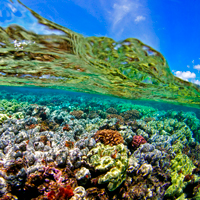
Climate Departure Date
View the page for this story
Scientists at the University of Hawaii have figured out a way to pinpoint when weather extremes at a given location will move outside the range of anything we’ve known in modern times. Geographer Abby Frazier, a co-author on the paper in Nature, tells host Steve Curwood it’s going to be sooner then we might think. (06:25)
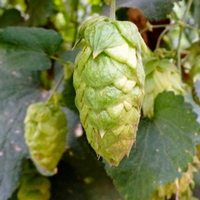
Outdoor Workers and Climate Change
/ Courtney FlattView the page for this story
Adapting to a future of rising temperatures will be especially hard for people who work outdoors during the summer. Courtney Flatt of the public media's EarthFix, reports that Washington state now requires employers to take the heat into account in order to provide safe working conditions. (05:35)
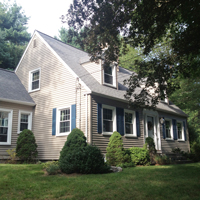
Power Shift - Home Energy Retrofit
/ Poncie RutschView the page for this story
There are many ways to make your home more energy efficient. In Massachusetts a partnership of northeastern utility companies aims to guide residents through these choices by providing free advice on cheapest ways to save energy. As part of our ongoing Power Shift series, reporter Poncie Rutsch followed a home energy auditor to see how the program works. (10:45)

Alaska’s Pebble Mine Loses a Partner
View the page for this story
Mining giant Anglo American has pulled out of a partnership to develop the massive Pebble Mine in Southeast Alaska. Conservation groups are pleased, as the mine would stand at the headwaters of the most productive salmon run in the country. But the mine could produce some $300 billion worth of minerals, so Mike Mason, news director at KDLG in Bristol Bay, Alaska tells host Steve Curwood the proposal may not be dead. (07:45)
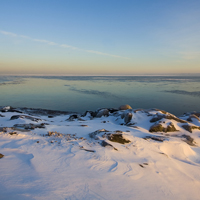
A Great Change For a Great Lake
View the page for this story
In the last 30 years Lake Superior, one of the largest deepest and coldest fresh water lakes in the world, has warmed nearly six degrees Fahrenheit. The increased temperature is a boon to some fish species, such as the highly prized walleye, but warmer water also boosts numbers of invasive species like the sea lamprey. Host Steve Curwood hears more from Jim Kitchell from the University of Wisconsin. (06:25)

Counting Down the Planet
View the page for this story
Alan Weisman’s bestselling book The World Without Us imagined our world if humans suddenly vanished from the planet. Weisman’s new book, Countdown, looks at an opposite reality; the earth with potentially far too many of us. Host Steve Curwood discusses the new book and the hot-button issue of reducing population with Alan Weisman. (10:25)
Show Credits and Funders
Show Transcript
Host: Steve Curwood
Guests: Abby Frazier, Mike Mason, James Kitchell, Alan Weisman
Reporters: Courtney Flatt, Poncie Rutsch
[THEME]
CURWOOD: From Public Radio International, this is Living on Earth.
[THEME]
CURWOOD: I’m Steve Curwood. Scientists are finding that the Earth is shifting into uncharted climate territory much sooner that you might think.
FRAZIER: Most places on Earth will start experiencing unprecedented climates by 2047, and these changes are expected to happen soonest in the tropics, as soon as 2020 in some locations.
CURWOOD: What this might mean, and why the tropics get hit first. Also, hotter summers and what that means for the health of the people who harvest our food.
RIVAS: This summer, we’ve had some record temperatures, days of over 100 degrees. You’ve got a lot of crops out here that, once they’re irrigated, the humidity inside there is just tremendous, and then the workload that some of these folks have puts a strain on their bodies.
CURWOOD: And the riches of mining versus the riches of nature. We'll have those stories and more this week on Living on Earth. Stick around.
[NEWSBREAK MUSIC: Boards Of Canada “Zoetrope” from “In A Beautiful Place Out In The Country” (Warp Records 2000)]
ANNOUNCER: Funding for Living on Earth comes from Stonyfield Farm. Makers of organic yogurt, smoothies and more.
Climate Departure Date

Shallow native coral reefscape, Hawaiʻi. Coral reefs, located in the tropics, will be some of the first ecosystems to experience climate departure. (photo: Keoki Stender, Marinelifephotography.com)
CURWOOD: From the Jennifer and Ted Stanley Studios in Boston this is Living on Earth. I’m Steve Curwood. When it comes to forecasts of global climate disruption, there are a lot of computer models and numbers out there. Much of the data seems abstract, and the focus is often on the end of the century. But a study from scientists at the University of Hawaii has come up with concrete numbers that are easy to grasp - the exact moment when the climate in a given place will go outside the range of anything we've experienced in the last 150 years.
Abby Frazier is a researcher in geography at the University of Hawaii. She and her co-authors crunched the results of hundreds of climate research studies and models for a paper in Nature. The result? Startling predictions of just when climate norms will be outside the range of what we now regard as extremes.

The study found that the tropics will be the first region to experience climate departure (photo: bigstockphoto.com)
FRAZIER: For a lot of people looking at parts per million CO2 or degrees warming, it’s fairly abstract. So we thought that by giving a year of when we can start to expect these changes, it would help connect people more closely to the issue, and hopefully get them involved and aware of how urgent it is that we start to take action now.
CURWOOD: And what were your results?
FRAZIER: We found that globally, we can expect that most places on Earth will start experiencing unprecedented climates by 2047, and that these changes are expected to happen soonest in the tropics, as soon as 2020 in some locations.
CURWOOD: Unprecedented? What does that mean?
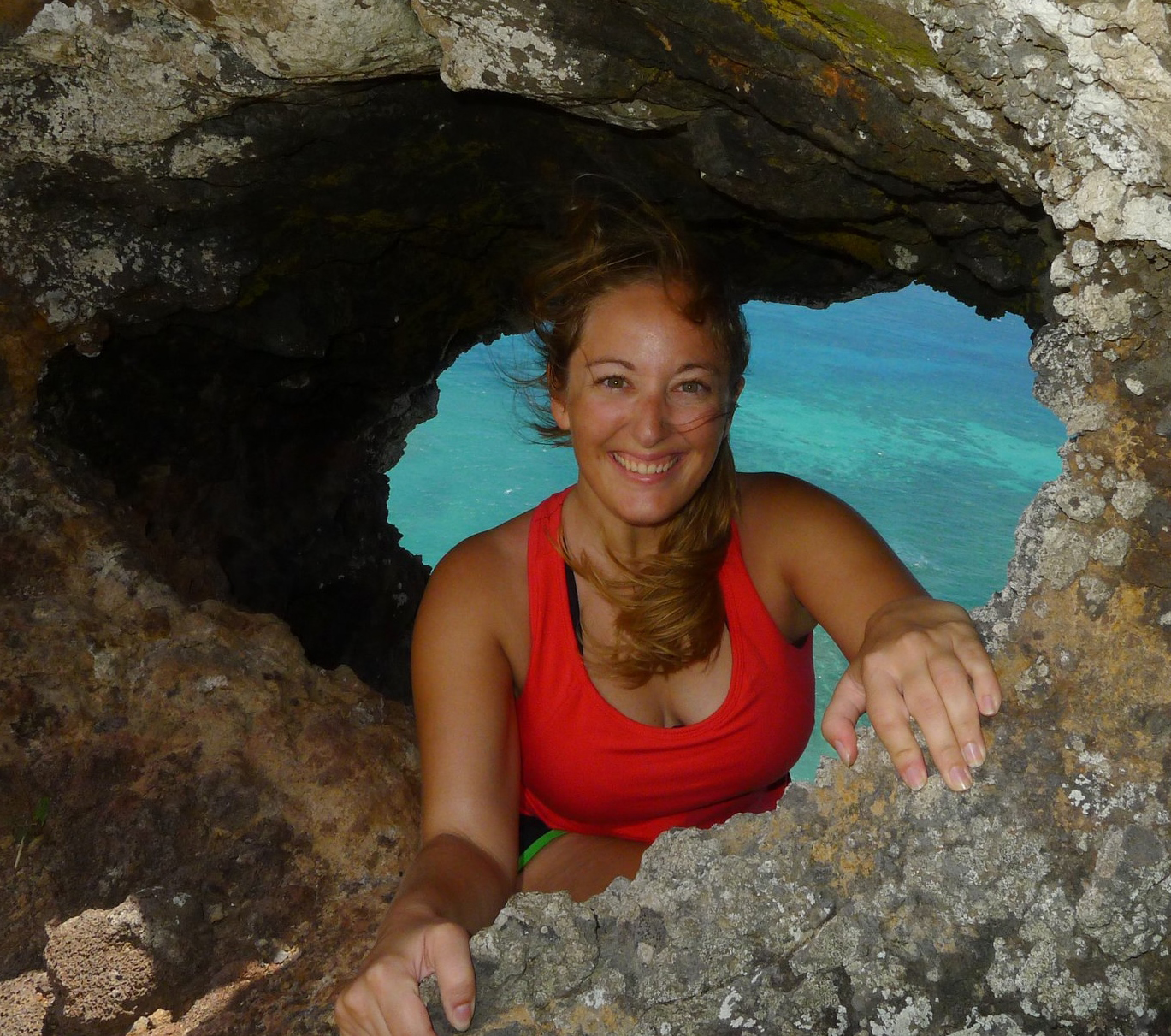
Abby Frazier (photo: Abby Frazier)
FRAZIER: What we did is we looked at the minimum and maximum temperatures that every location has experienced in the last 150 years, and we set those as the bounds of historical variability, and we then determined the year that the temperature goes outside of those bounds, of the minimum and the maximum that we’ve seen in the last 150 years, and we named that as the year of climate departure - when it goes outside the bounds and does not come back in.
CURWOOD: And you say this could happen in the tropics as quickly as seven years, within a decade?
FRAZIER: Exactly. Within a decade. And so the reason for this is that the tropics have a small natural climate variability. Their climate is relatively stable, so it doesn’t take much in terms of absolute changes to exceed those small bounds of natural variability.
CURWOOD: This is really interesting because we’ve been hearing all along that the coldest parts of the world, the Arctic and the Antarctic, are experiencing the most rapid warming.
FRAZIER: Yes. So that’s true. Most of the conversation on climate change focuses on the areas that will experience the largest absolute changes, but what our study is showing is that the tropics might be even more vulnerable than the high latitudes because they will start experiencing these changes first. Most of the world’s species are located in the tropics, and those species are adapted to these very narrow climate bounds, so it doesn’t take much to exceed what these species can tolerate.
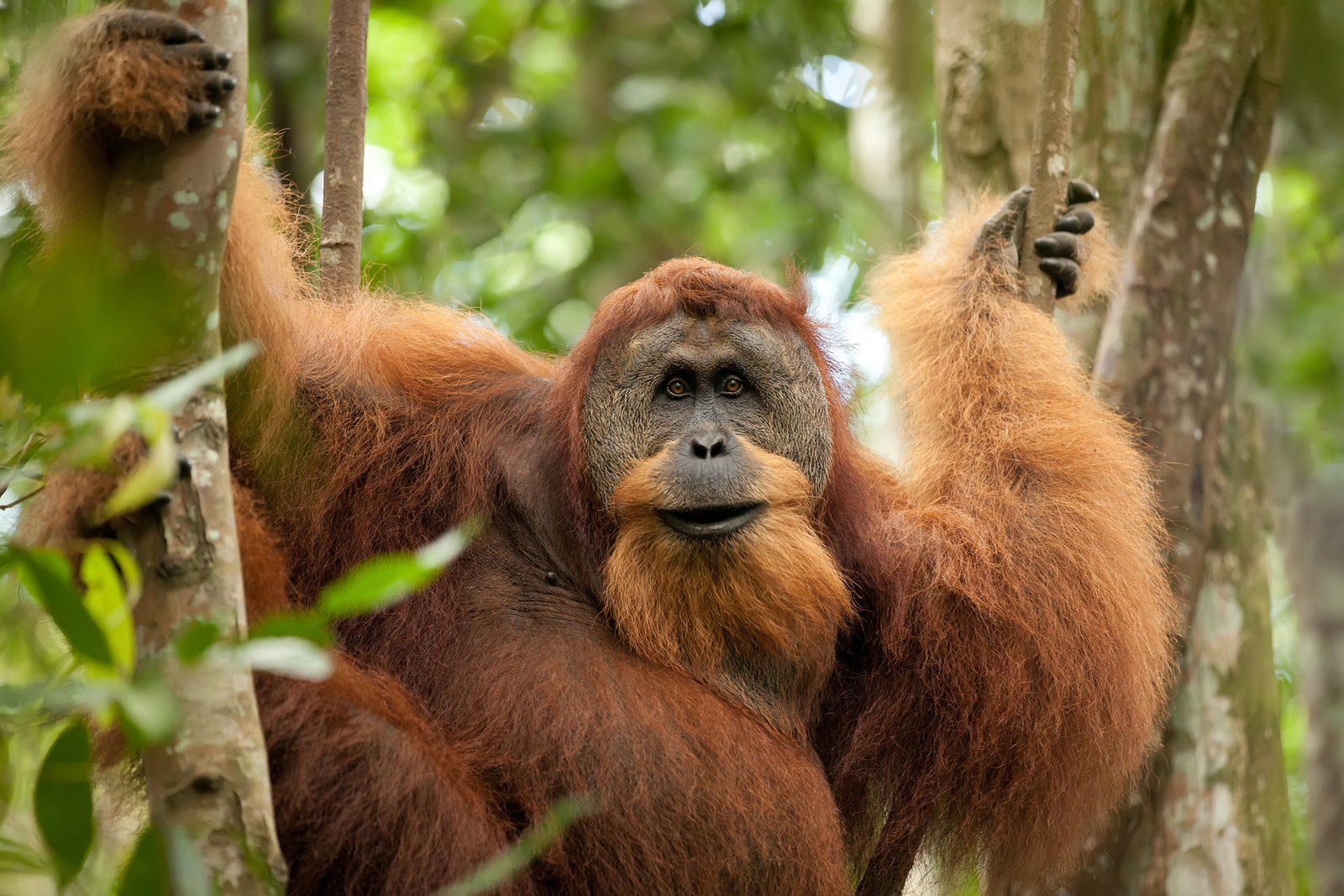
Many species will have a very hard time coping with the higher extreme temperatures that are coming down the pike (photo: bigstockphoto.com)
CURWOOD: What are the consequences on biodiversity in the tropics of this kind of warming do you think?
FRAZIER: It’s hard to predict the precise implications for specific species, but we know the responses could be massive. We’ve seen responses in species for recent extreme events that we’ve experienced, and we’ve seen species that try to move, other species that try to adapt to the changes, and others experience massive die-offs or even extinction. So we can expect responses along the whole spectrum.
CURWOOD: Why are the tropics important for humans?
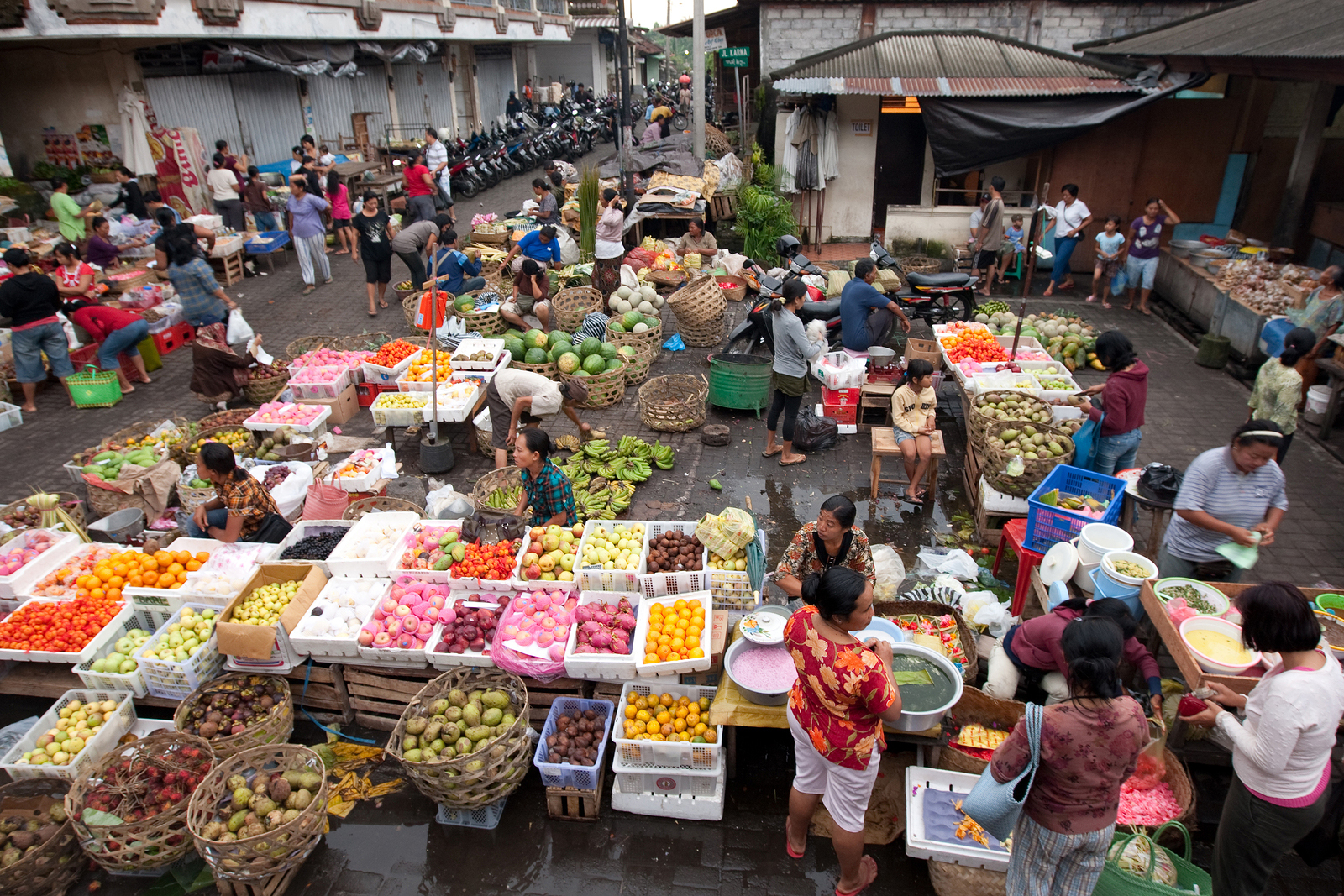
A fruit market in Bali, Indonesia. The majority of the world’s people live in the tropics, and will struggle to adapt to climate extremes. (photo: bigstockphoto.com)
FRAZIER: Most of the world’s population is actually concentrated near the tropics, and many countries in the tropics tend to have some of the lowest GDPs in the world. So these countries that are going to be hit first by unprecedented climates have the least economic capacity to respond, and these countries have ironically contributed the least to this change in the first place. So people in the tropics are going to start seeing these changes by 2020 in some places and by the year 2050, we expect five billion people around the world to be experiencing these unprecedented climates.
CURWOOD: How inevitable is all of this? What if we slash our current emissions?
FRAZIER: We analyzed two future greenhouse gas emissions scenarios in our study. We found that if we continue with our business as usual, that’s when we’ll reach this -- 2047. And even if we are able to cut our greenhouse gas emissions and take on this global mitigation effort, we find the year of climate departure on average will still happen by 2069, so that’s just 22 years into the future from the date if we do nothing.
CURWOOD: How surprised were you by these results?
FRAZIER: I think I was very surprised. We were very conservative in our whole analysis using the minimum and maximum, using every model we could get our hands on, and I think we expected, using this conservative greenhouse gas emissions scenario, that the climate departure wouldn’t happen within this century. So I think we were very surprised to find that even if we do take great action now, it’s still going to happen.
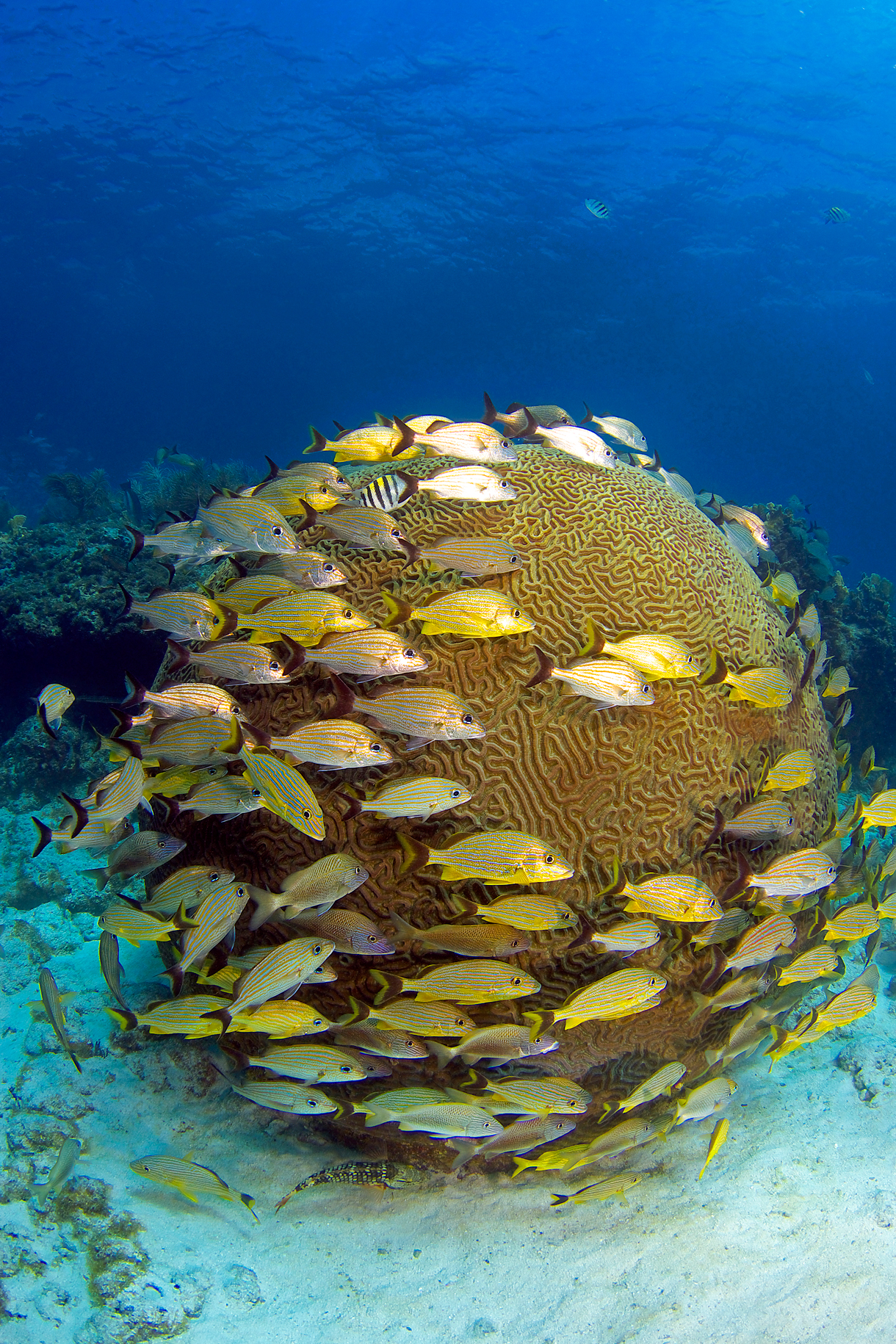
Boulder brain coral, surrounded closely by snappers, Key Largo, Florida. Tropical fish species will need to adjust to changing temperatures. (photo: Keoki Stender, Marinelifephotography.com)
CURWOOD: Abby, the research that you’ve helped developed here shows we’ll have this climate departure as you call it, as soon as 2020 in the tropics and for the rest of the planet before the middle of the century. How do you feel in response to finding this data?

Watershed overseeing coral reefs, Kāneʻohe Bay, Oʻahu, HawaiʻI (photo: Keoki Stender, Marinelifephotography.com)
FRAZIER: It’s kind of a mix of emotions. It’s very very sobering that these years are happening so soon and within our lifetime, and I think that’s what’s hitting us the most. On the one hand, it’s very exciting for me as a young PhD student to be publishing a paper in a journal like Nature, but the implications of the results are very striking. But the other thing that I think comes out of this for me, in terms of emotions, is hope that these numbers will end up maybe in policy decisions or can help just raise awareness about the issue. I think despite the fact that these numbers are fairly scary, it’s exciting in some ways that putting this out there we can actually make a difference.
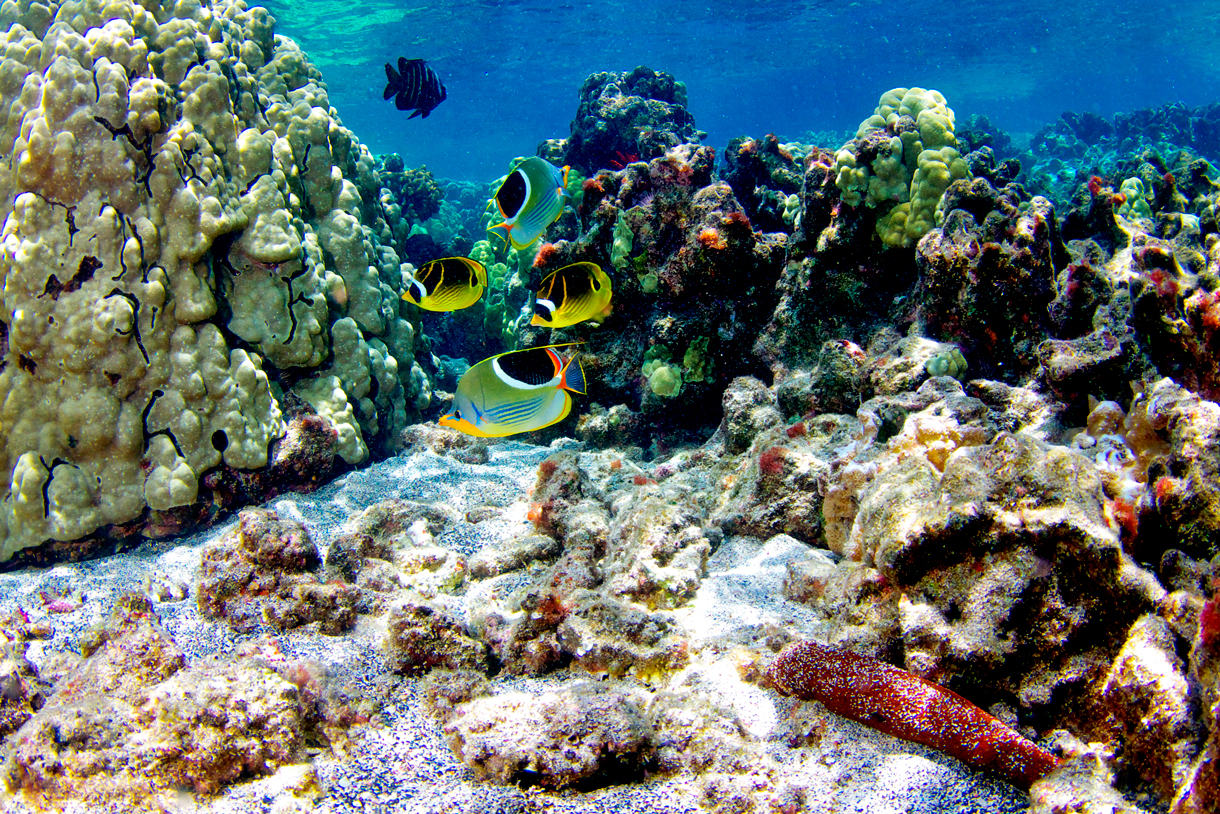
Saddleback and Racoon Butterflyfishes in shallow reef flat, HawaiʻI (photo: Keoki Stender, Marinelifephotography.com)
CURWOOD: Abby Frazier is a researcher in geography at the University of Hawaii. Thanks so much for taking this time, Abby.
FRAZIER: Thank you so much for having me.
Related links:
- Check out an interactive map of the climate departure dates around the world
- Read the paper here
- Abby Frazier’s website
Outdoor Workers and Climate Change
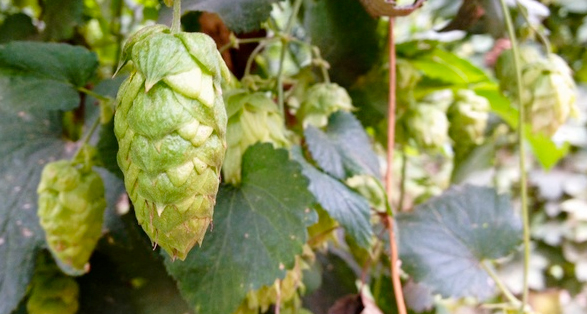
For 20 years, Victor Gonzalez has traveled the Pacific Coast picking cherries, pears, and apples. He said he came close to passing out once from the heat. Migrant workers are particularly vulnerable to health problems from heat. (photo: Courtney Flatt)
CURWOOD: Now, given the rapid progress of climate change, if you work outdoors in the summertime, you’d better learn to take the heat. That’s true for people who repair roads, landscape yards, build houses, or pick crops. Too much exertion and not enough shade or water, and you are headed for trouble. From the public broadcasting collaborative EarthFix, Courtney Flatt reports for our series, “Symptoms of Climate Change”.
FLATT: For 20 years, Victor Gonzales has traveled the West picking crops. In the Northwest that means Oregon pears and Washington apples. During this point in the harvest season, Gonzales wakes up at 5:30 every morning. He heads to the pear field that’s next to his migrant worker housing. He’s staying in a prefabricated metal unit. It’s one of several the orchard owner provides for farmworkers to live in. In the summers, temperatures at this Hood River orchard can reach 100 degrees. Gonzales remembers one day when he’d been working really hard. He was sweating more than normal.
GONZALES (translated): He feels like he was going to pass out, very shaky, very, very sleepy. And they told him not to sleep. He had to go home and drink a lot of water and rest until he recovers.
FLATT: Gonzales says a friend of his once went to the hospital after getting too hot in the field.
GONZALES (translated): He felt weak and was vomiting.
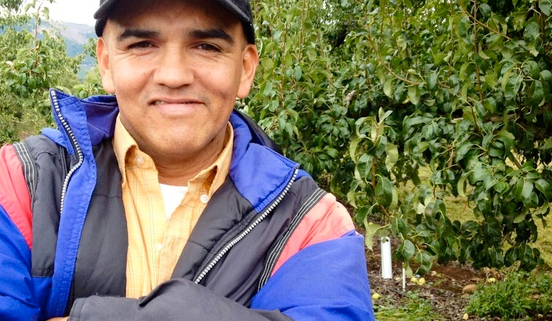
For 20 years, Victor Gonzalez has traveled the Pacific Coast picking cherries, pears, and apples. He said he came close to passing out once from the heat. Migrant workers are particularly vulnerable to health problems from heat. (photo: Courtney Flatt)
FLATT: Farm labor has always been strenuous. Dealing with the heat has always been a part of the job, but researchers say climate change is causing more outdoor workers to get sick more often. Jeffery Bethel is with Oregon State University. He’s been studying the connection between warming temperatures and farmworker health.
Bethel’s climate models show average summer temperatures in the Northwest are increasing. By mid-century, they could be as much as 9 degrees higher than they are today.
BETHEL: And not only that, the number of heat extreme events will also increase. It’s likely that these outdoor workers will experience a greater number of heat-related illnesses.
FLATT: Migrant farmworkers are especially vulnerable to ill effects from higher temperatures. Their access to health care is more limited than it is for other workers. And sometimes their housing doesn’t provide much refuge from the heat. On one farm in the Dalles, Oregon, migrant worker advocates say even on the hottest nights, workers sleep outside. That’s because it’s even warmer in their oven-like rooms.
After several highly publicized, highly preventable worker deaths about a decade ago, Washington and California passed laws that regulate outdoor workers’ heat exposure. They’re the only two states in the country with laws that specifically protect outdoor workers from the heat.
[CONVEYOR BELT]
FLATT: Raymundo Rivas walks through a hops field in central Washington’s Yakima Valley. As a teenager Rivas helped harvest the crop that gives beer its tangy bite. Nearby, a conveyor belt takes the fresh flowers to be dried. Now Rivas works for the state’s Department of Labor and Industries. Rivas helps educate workers and employers about the rules that are designed to keep outdoor workers cool and healthy. That’s especially important as temperatures continue to rise.
RIVAS: This summer, we’ve had some record temperatures, days of over 100 degrees. You’ve got a lot of crops out here that, once they’re irrigated, the humidity inside there is just tremendous. And then the workload that some of these folks have, puts a strain on their bodies.
[SOUNDS OF MEDICAL CLINIC]
FLATT: At the Yakima Valley Farmworkers Clinic, about twenty people sit in the waiting room. Some line up to fill prescriptions. Children play at the back of the room, while their parents wait for their names to be called.
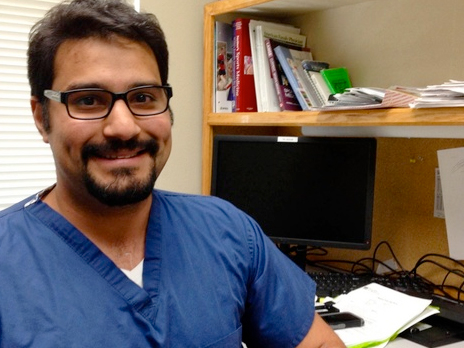
Alberto Jacir has been a family doctor at the Yakima Valley Farmworkers Clinic for three years. Even though working conditions have improved over the years, Jacir said as days get hotter, conditions still need to get better. (photo: Courtney Flatt)
Alberto Jacir has been a family doctor here for three years. He says farmworkers actually stop showing up for medical appointments during summer harvest. That’s because they can’t afford to take days off.
JACIR: This is their bread and butter, working in these critical harvest months. I’m not a person to say, ‘don’t go to work’. We just talk about the dehydration part, what is dehydration? Signs and symptoms of dehydration.
FLATT: Jacir says as days get hotter, farmworker conditions need to get better.
JACIR: It’s something that I do believe needs to be not overlooked. They’re important drivers of the economy. They are very hard workers, and they should have the best conditions for such hard manual labor.
FLATT: Migrant farmworker Victor Gonzales says conditions have gotten better over the past 20 years: Growers now provide water; bathrooms are cleaner.
Farmer Alan Schreiber says that’s always been the case at his asparagus farm in Central Washington. He says farmworkers have access to water, ice, and shade. And they’re allowed to take regular breaks. Schreiber says farmers won’t get their crops picked if they don’t look out for the well-being of their workers.
SCHREIBER: This is the cold, hard reality. We’re short on labor. We do not have enough workers. Anyone who does not treat their workers with respect and treat them well enough and pay them well enough, those workers will get up and move.
FLATT: Back in Hood River, Gonzales looks out at the pear orchard where he picks fruit every day. He says he’s sat in on many training classes in Washington and California. He’s watched videos on how to keep cool and what to do if anyone gets sick.
GONZALES (translated): We know we have to drink water, and sometimes we have to take off our shoes and take a break for five minutes, 10 minutes.
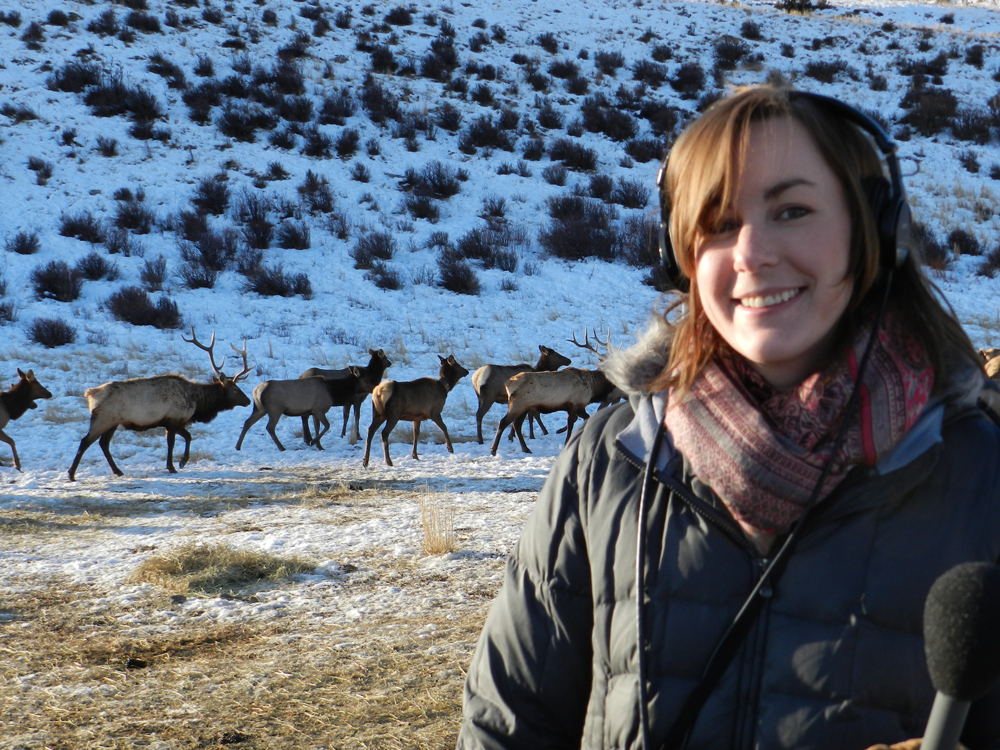
Courtney Flatt (photo: EarthFix)
FLATT: Those breaks will be even more critical for future generations of outdoor workers. Consider this: Right now, eastern Washington doesn’t typically see more than two stretches with temperatures above 100. But by 2085, those triple-digit heat waves could hit the area six times each summer.
CURWOOD: That was Courtney Flatt. She reports for the public broadcasting collaborative EarthFix. To see photos from this series "Symptoms of Climate Change", check out our website, LOE.org.
Related links:
- Check out the rest of the EarthFix series—Symptoms of Climate Change
- Courtney Flatt’s page at EarthFix
[MUSIC: The Keynoters with Nat King Cole “I Can’t Believe That You’re In Love With Me” from The Keynoters With Nat King Cole (Mercury Records 1987)]
CURWOOD: Coming up...tapping into public programs to save money on heating and cooling your home. Keep listening to Living on Earth.
[CUTAWAY MUSIC: Zoot Sims: “I’m Getting Sentimental Over You” from Getting Sentimental (Candid Records 1974) RIP “The Jazz Lobbyist” Dick LaPalm (1927 – 2013)]
Power Shift - Home Energy Retrofit
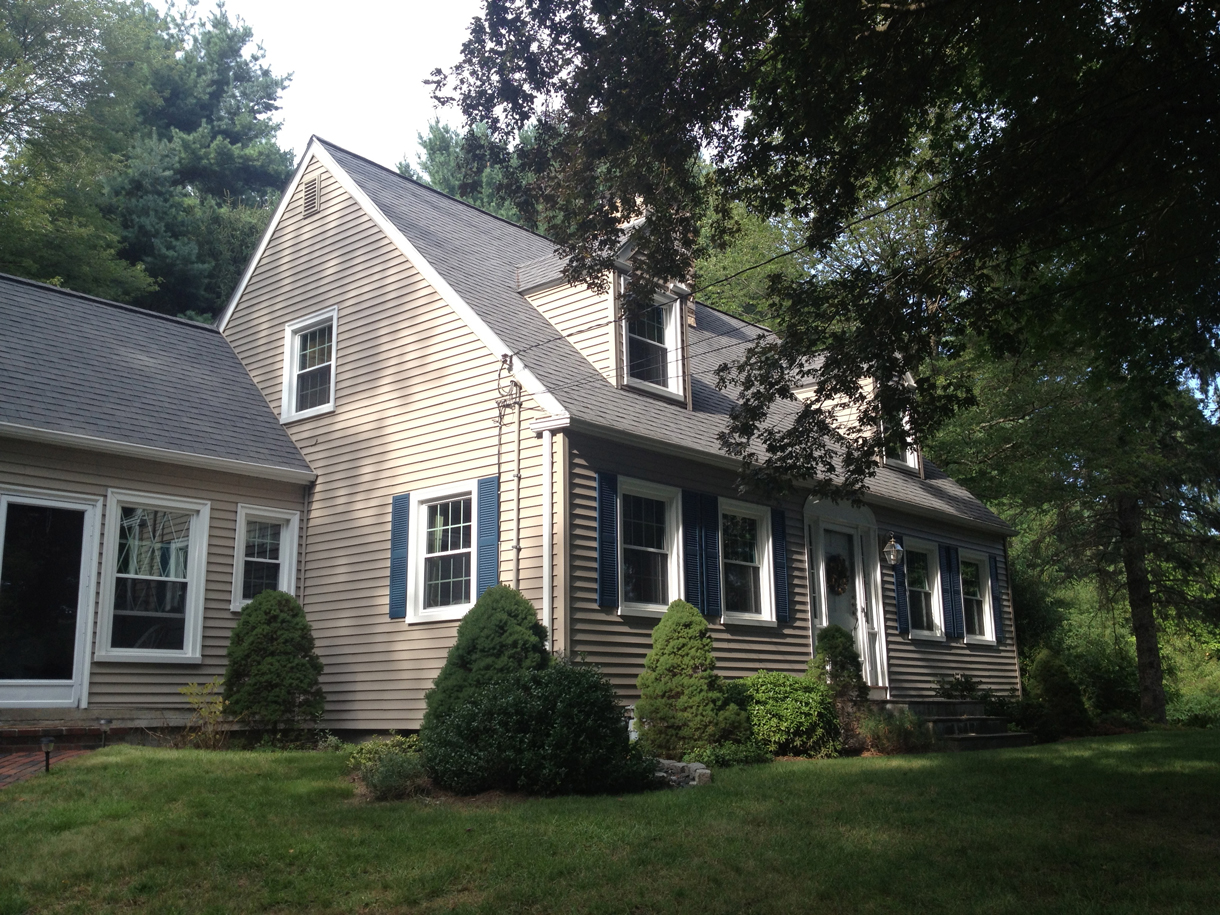
The Wesolowskis are trying to lower their energy bills at their house in Ashland, Massachusetts. (Photo: Poncie Rutsch).
CURWOOD: It’s Living on Earth, I’m Steve Curwood. And now, our occasional series on energy transformation, Power Shift.
[MUSIC: PAT METHENY- (ACROSS THE) HEARTLAND---FROM AMERICAN GARAGE]
CURWOOD: For two years, the American Council for an Energy-Efficient Economy has dubbed Massachusetts the greenest state in the nation, based on its policies to spur energy efficiency. One area where the Bay State shines is in its push to revamp and weatherize old housing stock. Every home can receive an annual visit from an energy efficiency guru who can advise the householder how to save the most energy for the least money. Living on Earth's Poncie Rutsch tagged along with a home assessor.
RUTSCH: It’s a clear New England day. John Brochu has just arrived at his first home assessment of the day - a typical New England cape-style house in Ashland, Massachusetts.

John Brochu, an energy auditor for Next Step Living, tests the efficiency of the HVAC system at the Wesolowski house in Ashland, Massachusetts. He can then tell the family about the possible discounts and rebates they can use to replace it for a more efficient one. (Photo: Poncie Rutsch).
BROCHU: Alrighty.
RUTSCH 2: Brochu works for Next Step Living, one of several hundred companies in the Northeast that analyze houses for energy saving opportunities, all in ways eligible for state-sponsored savings through the MassSave program, a partnership funded by utility companies. Today he’s assessing the house of Heidi and David Wesolowski.
BROCHU: Well thanks for having us out. Have you ever had an audit before?
WESOLOWSKI: No, we have not.
BROCHU: And you’ve only been here for a year I see.
WESOLOWSKI: We moved in June last year.
BROCHU: OK, alright, cool.
RUTSCH: The Wesolowskis are trying to save energy where they can. There are dozens of ways: insulate the house, replace incandescent lightbulbs, buy high efficiency appliances. All of these choices use less energy, but some are really expensive. If you’re on a budget, you can’t do it all, and it gets very confusing. Here’s Next Step Living CEO Geoff Chapin.
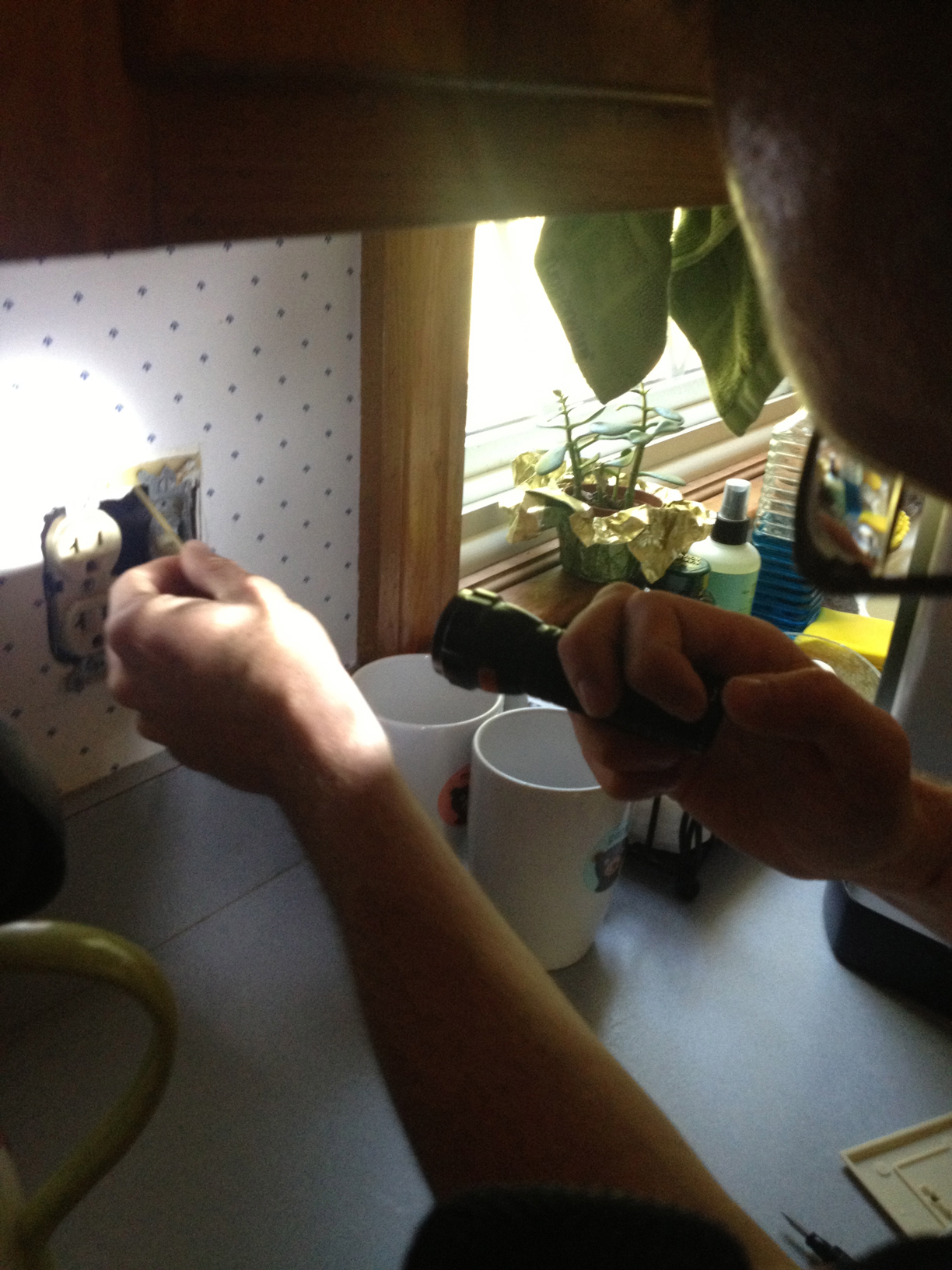
John Brochu, an energy auditor for Next Step Living, uses a barbecue skewer to determine how much insulation is between the walls at the Wesolowski house in Ashland, Massachusetts. (Photo: Poncie Rutsch).
CHAPIN: We really want to make a difference in terms of energy and climate.
RUTSCH: Next Step Living assessed nearly 18 thousand homes between January and the end of August this year. Before Brochu starts, he asks Heidi Wesolowski about her goals.
WESOLOWSKI: Well we moved in about a year ago. We would particularly like to look at the insulation and the heat escape because we know that the heating bill goes up in the winter time. And this year we have a baby so we’re home all day and we can’t turn the heat down while we leave during the day. We can’t turn the heat down at night time because he needs to be comfortable while he’s sleeping. So we have to go other ways.
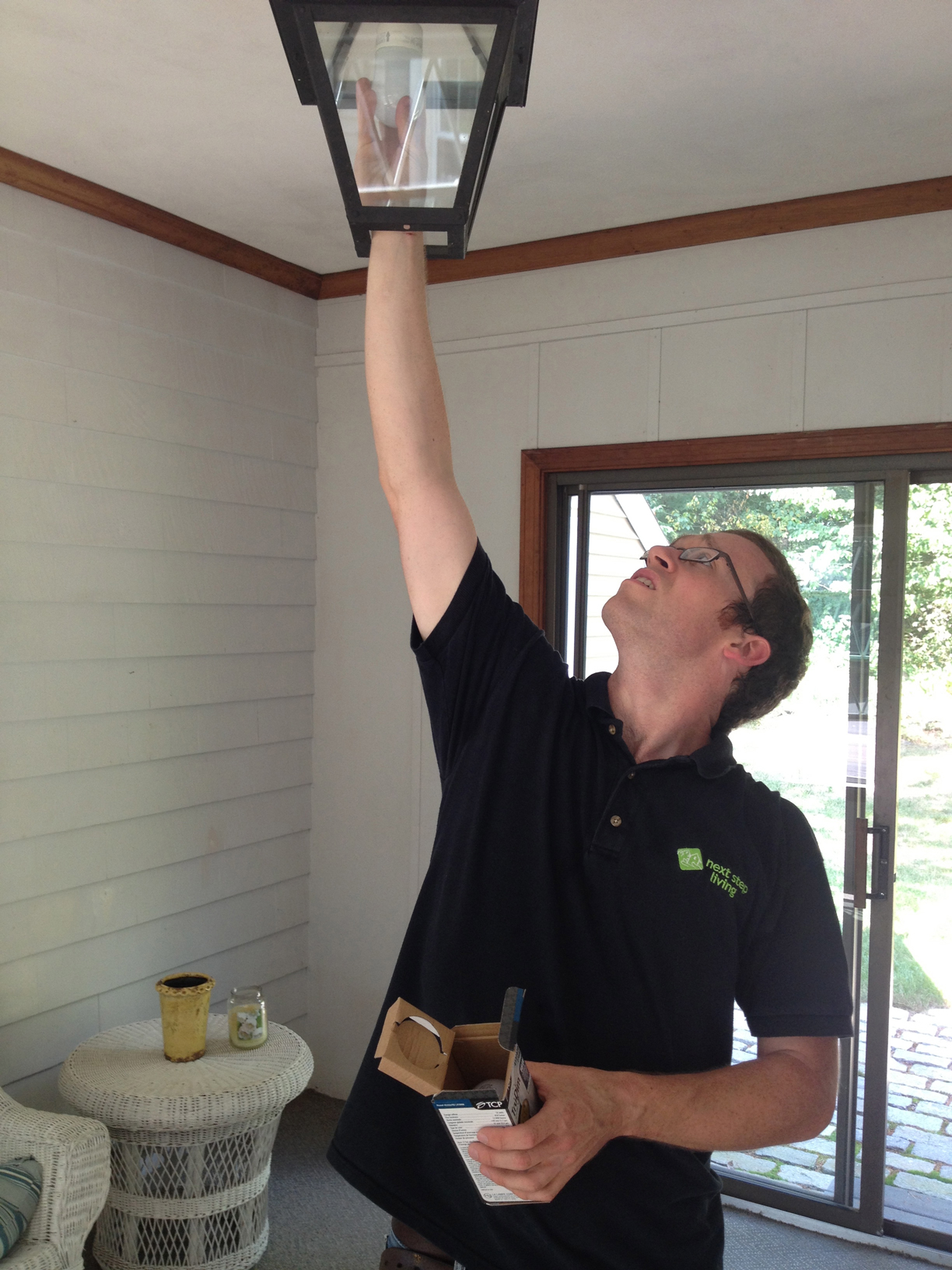
John Brochu, an energy auditor for Next Step Living, installs a more efficient CFL lightbulb at the Wesolowski house in Ashland, Massachusetts. The Mass Save program allows him to install as many lightbulbs as he has time for, free of charge. (Photo: Poncie Rutsch).
BROCHU: So I’ll just take a walk around out back.
[DOOR OPENS AND FOOTSTEPS]
RUTSCH: We circle the outside of the house slowly and Brochu scans the clapboard walls for any openings where heat could escape.
RUTSCH: Then we head back inside.
[SOUNDS OF SQUEAKY DOOR]
WESOLOWSKI: Welcome to our very inefficient door. We know for sure this door is an issue because it’s an old hatch door. And in the winter we can feel the air coming in through it.
RUTSCH: Brochu says that their stable door, with its separate bottom and top halves, can be sealed too.
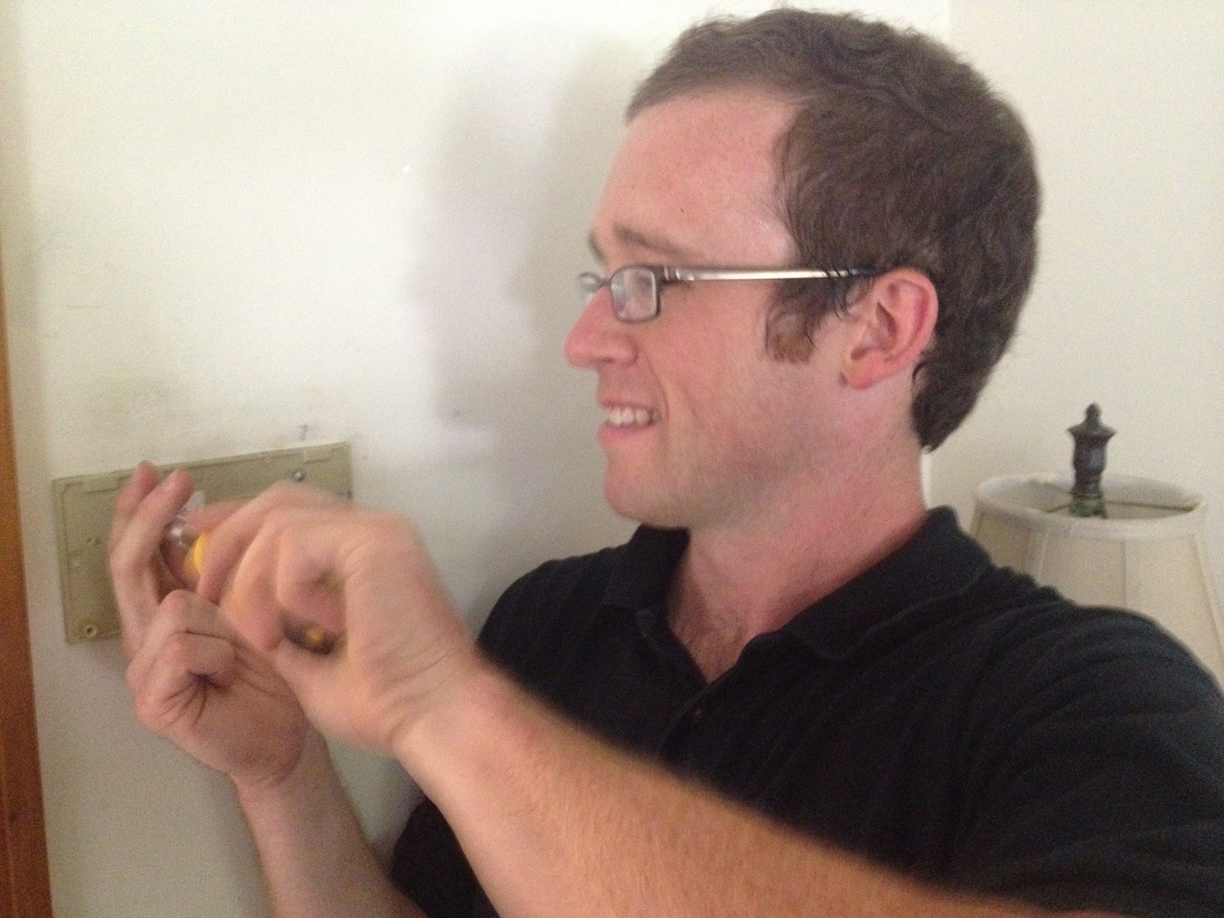
John Brochu, an energy auditor for Next Step Living, installs a new, programmable thermostat at the Wesolowski house. (Photo: Poncie Rutsch).
BROCHU: I’ve seen, where they actually have built in weather stripping here.
RUTSCH: Then, Brochu walks around the first floor inside, flipping switches on and off as he walks.
[EXHAUST FAN TURNS ON]
RUTSCH: Exhaust fans, like those above the stove and in the bathroom, sweep air from inside the house to the outdoors. Then there’s the chimney, a pretty big hole to the outside.
WESOLOWSKI: This fireplace is a functioning fireplace, but we do not use it.
BROCHU: OK, alright. Do you have a way of closing the flue there?
RUTSCH: Brochu flips on his flashlight and cranes his neck up the chimney
BROCHU: So it’s definitely good to make sure that this is closing, and it looks like it is.
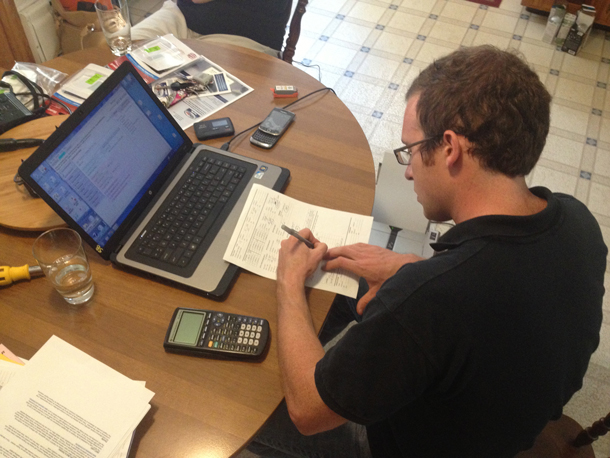
John Brochu writes down some notes and performs some quick calculations to figure out how these homeowners can save the most energy for the least expense. Brochu works as an energy auditor for Next Step Living, and he’s assessing the Wesolowski house in Ashland, Massachusetts. (Photo: Poncie Rutsch).
RUTSCH: When we finally make it to the basement, Brochu takes a quick look around and notes that the windows in the basement are single pane.
BROCHU: A lot of the hot air naturally wants to rise, right? But that movement called the stack effect also draws in cold air from lower extremities. So you have this motion of cold air coming in through the basement and hot air escaping up and out the attic.
RUTSCH: Then Brochu moves over to the hulking machines in the basement, the hot water boiler and the HVAC system. He uses a meter to see how much carbon monoxide is coming out.
BROCHU: We need to see it below 100 parts per million. She’s at 186.
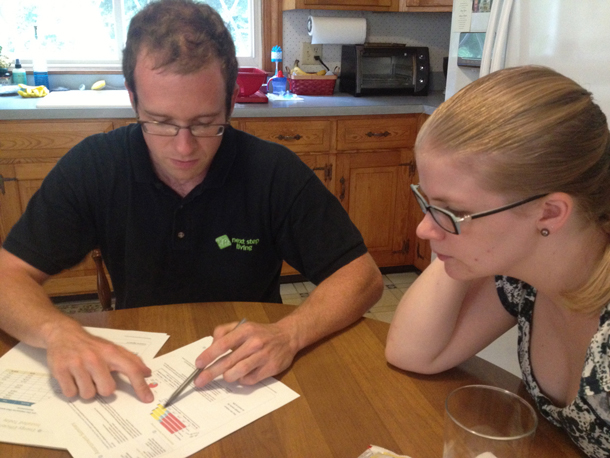
John Brochu shows Heidi Wesolowski her options for retrofitting her home to save energy. Brochu works as an auditor for Next Step Living, Wesolowski house in Ashland, Massachusetts. (Photo: Poncie Rutsch).
RUTSCH: Brochu tests the efficiency and says the Wesolowskis could save energy by upgrading their boiler. Plus, the boiler's old and will need to be replaced in the next few years. He records these numbers and then switches the heat off.
[HVAC TURNS OFF]
[BASEMENT STAIRS]
RUTSCH: Next, Brochu checks how well insulated the house already is.
BROCHU: So I’m going to go around and get an idea what’s behind the walls.
RUTSCH: Brochu breaks out his secret weapon.
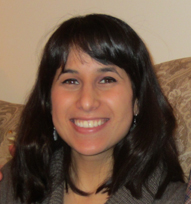
Monica Tawfik works for the home efficiency department of National Grid. Part of her job is to oversee companies like Next Step Living when they assess homes for energy efficiency. (Photo: National Grid).
BROCHU: This is just a really sophisticated barbecue skewer. So I’ll start by pulling off some outlet covers…
RUTSCH: Brochu pokes the skewer carefully into the sealed joints around the outlet. He’s listening closely and feeling for the fluffy insulation inside.
[SKEWER SLIDES INTO INSULATION]
RUTSCH: Brochu finds about three and a half inches of wall space, filled with two-and-a-half inches of insulation. He considers filling the remaining space with more insulation.
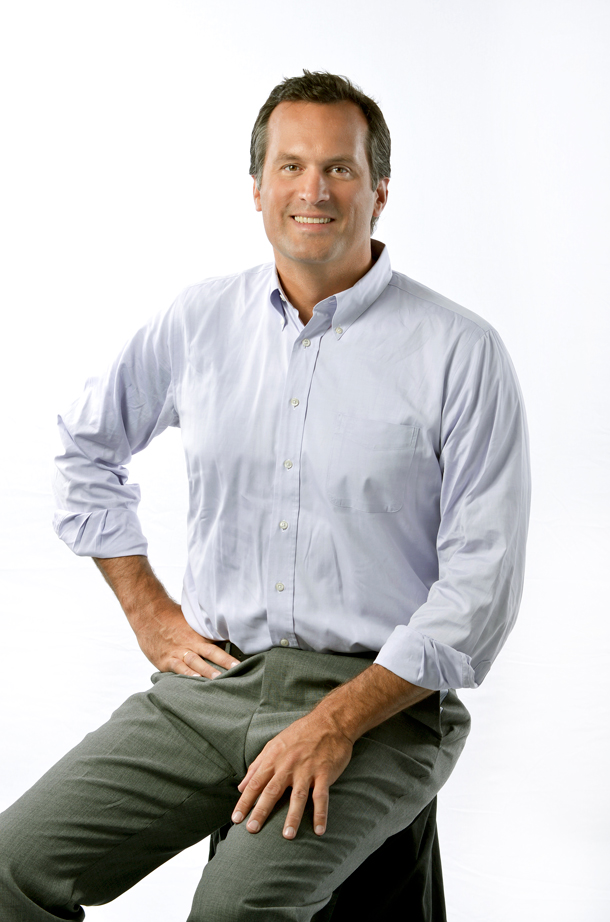
Next Step Living CEO Geoff Chapin says that the main goal of the company is to decrease energy usage and help the environment. (© 2013 Next Step Living, Inc. Photos: Perfect Bokeh Photography)
BROCHU: But if we only have inch of air space in there, the material doesn’t really install properly. So in this case we just have to call the walls good enough.
[ATTIC STAIRS]
RUTSCH: Then we move up to the attic.
BROCHU: The attic is, I kind of think of it as the hat on the house. So if attic is not properly air sealed and insulated, you lose a ton of heat out of that space.
RUTSCH: Brochu takes some notes on the space and how he could add insulation up here. Then it’s time for a lightbulb scavenger hunt. Brochu runs out to his car to grab a few of what he calls ISMs – Instant Savings Measures – or ways he can help the Wesolowskis right now.
[DOOR TO OUTSIDE; SOUNDS OF TRUNK OPENING]
RUTSCH: Brochu’s car is stuffed with energy saving toys – CFL lightbulbs, LEDs, smart power strips, new thermostats, and low flow shower heads.
BROCHU: Simple but really good example is the shower head. So, standard is two and a half gallons per minute, we have one that is one and three-quarter gallons per minute. So it seems pretty small but if you actually think about it that’s three-quarters of a gallon in a minute. Turns out to be quite a lot of water.
RUTSCH: He installs a new shower head in the bathroom, and then moves to lightbulbs.
BROCHU: Do you mind if I change this one out here?
[SCREWS IN A LIGHTBULB]
BROCHU: Alright, that works. Success.
RUTSCH: Brochu leaves as many lightbulbs as he possibly can.
BROCHU: There’s no limit, the only rule is that I have to leave them installed.
RUTSCH: And last, but not least, he looks at the climate control.
BROCHU: I notice you have two pretty old thermostats so I can give you some programmable ones.
RUTSCH: It’s taken Brochu about two hours to complete his assessment. He types up his notes and prints out his report.
BROCH: So this is a summary of what I did do today: showerheads, thermostats, etc. And the utilities, they subsidize this work 100 percent, so your total cost is that, zero, but the total cost paid by the utilities is $403.
RUTSCH: There are a few investments that Brochu suggests the Wesolowskis might make. They can get a discount on upgrading their hot water boiler and on insulating the attic. But before Next Step Living could install discounted insulation, the Wesolowskis would have to pay full price to remove some floorboards. Brochu is also pretty sure there'd be help to replace the drafty door.
BROCHU: That is, technically a single-paned window/door so that is financeable.
RUTSCH: But there’s a catch – it’s not a discount, it’s just a low interest loan.
BROCHU: So if you guys wanted to use the heat loan you could do that along with all the basement windows.
WESOLOWSKI: That might, yeah, be the way to go.
RUTSCH: Brochu hands Heidi a stack of papers. It’s easy to get overwhelmed by all the paperwork – the choices are endless. Out of all the homes that Next Step Living has assessed, less than half have completed the followup work like adding insulation or replacing windows. Home assessments are costly for the utility companies but they think it’s worth the expense.
TAWFIK: My name is Monica Tawfik. I am manager of the sales processing group here at National Grid.
RUTSCH: National Grid is one of about eight utility companies that pays for the MassSave program, which then contracts with companies like Next Step Living to assess people’s homes.
TAWFIK: The funding actually comes directly from your utility bill, so on every bill there’s a small surcharge that actually goes to fund the program.
RUTSCH: And in the end, saving energy is good for the energy utilities too.
TAWFIK: Energy efficiency actually helps us as a company by using less electricity or less gas. That’s one less power plant we need to build or invest in, so it’s less strain on our resources.
RUTSCH: Heavy snow and intense storms are common in the Northeast; anything utilities can do to reduce demand on the grid makes the system more resilient.
TAWFIK: So this year alone we are intending to serve 40,000 customers with home energy assessments and just through this program, we’re intending to save 14,000 megawatt hours on the electric side and over 1.5 million therms.
RUTSCH: That’s enough natural gas to heat 2,000 homes. Ideally, the people choosing to assess and weatherize their homes would be heavy energy users. But neither MassSave nor Next Step Living has analyzed who uses these programs. Both say that they really want to change the habits of the heavy hitters…the energy hogs. Here’s Monica Tawfik again.
TAWFIK: So we, obviously being the utility company, have access to the utility usage and bills so we do try to target the high energy users. But again the program really is available for anyone, whether you own the home, whether you rent the home, whether you’re a landlord, doesn’t make a difference. The opportunity’s there, the incentives are available for anyone.
RUTSCH: According to the Massachusetts Department of Energy and Environmental Affairs, nearly 75,000 homes and apartments received an assessment last year. Massachusetts has saved enough electricity to power nearly 5,000 homes for a year, and the program has helped the state reduce greenhouse gas emissions and meet the governor’s 25 percent reduction target for 2020.
So after all the assessing, we had to see what the Wesolowskis wanted to pursue.
WESOLOWSKI: Well we’re definitely interested in looking at the insulation. Something we thought about before we moved in. So it seemed like a good opportunity to get the insulation with someone who would know how to get us the savings that were associated.
RUTSCH: She says it’s partly about the environment and partly about saving money in her household.
WESOLOWSKI: I think it’s a combination of both. It’s great that you can do both at the same time, that one isn’t a tradeoff for the other. That when your energy consumption goes down you’re both saving money and helping the environment. It just seems like, why not?
RUTSCH: Why not indeed? For Living on Earth, I’m Poncie Rutsch in Ashland, Massachusetts.
Related links:
- Next Step Living
- Mass Save
[MUSIC: Steely Dan “Aja” from Aja (UMG Records 1977)]
Alaska’s Pebble Mine Loses a Partner
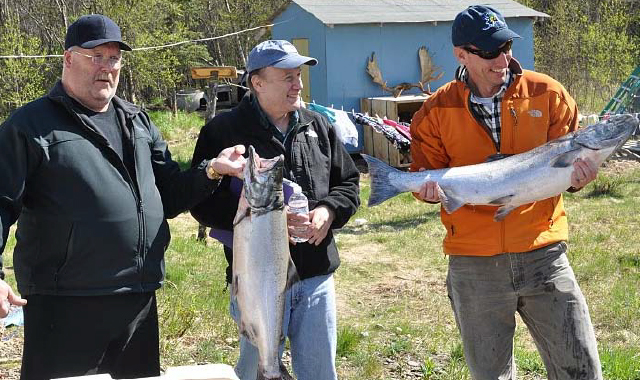
Fishermen pose with king salmon from local rivers. (David Allnutt, US EPA Region 10)
CURWOOD: The proposed Pebble Mine in Southeast Alaska would be located at the headwaters of some of the most productive salmon rivers in the world. The potential threat there prompted conservation groups, fishermen, and native tribes to oppose the mine. And recently, the international mining giant Anglo American decided to pull out of the partnership to develop the site.
But as the mine could produce some $300 billion worth of minerals including gold and copper, Mike Mason, the news director at public radio station KDLG in Bristol Bay, says that might not be the end of the story. It's a classic case of the riches of mining versus the riches of nature.
MASON: Well it is basically a very pristine environment. There’s very little population up there, and it is basically at the headwaters of the Bristol Bay drainages, or at least two of the major drainages, the Nushagak and Kvichak river drainages, which are two of the largest salmon producing rivers on Earth and definitely very vital to the environment here in Bristol Bay, and the mine potentially would be located just north of Lake Iliamna which is considered the largest salmon producing lake on Earth.
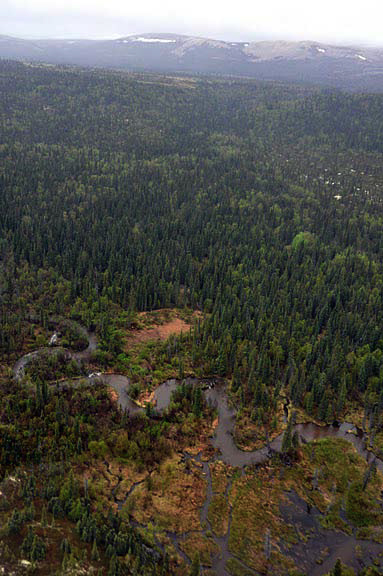
Upper Talarik Creek near the proposed Pebble Mine. (David Allnutt, US EPA Region 10)
CURWOOD: Describe the proposed mine for me. They call it Pebble Mine, but I don’t think they’re mining pebbles! And tell me about the concerns locally about the possible environmental impact.
MASON: Well, perhaps we should start on what we don’t know, and what we don’t know is the size and the scope of the proposed mine. Many people believe that it would be massive, likely the largest mine in Alaska, and likely one of the largest mines in North America. The plan potentially would include a massive open pit, but like I said, much of that is unknown because the developer, now Northern Dynasty Minerals, has not released a mine plan, nor have they filed for the necessary permits that would start the NEPA [National Environmental Protection Act] permitting process.
So what we know is a little bit, but we don’t know the full scope of it. We were hoping we would get the mine plan later this year, and with the goal they were saying of potentially going into permitting by the end of this year or early next year, but all of that appears to be on hold with the recent decision by Anglo American to pull out of the project.
CURWOOD: Now, why did the mining company decide to pull out of this project?
MASON: Well, that’s the big question. They were undergoing a review of all of the projects that were basically in their pipeline, and Anglo American is a mining giant worldwide - they’ve got projects all over the world - and they did an assessment of all their projects as part of their budget process and they came up with the decision that basically there were other projects it seemed like that were further along in development and would not be as risky as this project. So they basically looked like they cut their losses, and walked away from it. Looks like they invested about $500 million so far, and it’s anticipated the company’s going to take a loss of another $300 million to get out of the Pebble Limited Partnership that was formed in 2007 between Anglo American and now the lone company involved here, Northern Dynasty Minerals.
CURWOOD: I gather that Northern Dynasty really doesn’t have that much experience in terms of mining on a scale like this. What are their plans going forward? Who might be the potential partners?
MASON: Well, that also is another big question mark. Northern Dynasty Minerals itself has never itself done a mine. One of the obvious potential partners is the giant mining company Rio Tinto, which owns basically nearly a 20 percent stake in Northern Dynasty Minerals, however Rio Tinto has said repeatedly that they will only support the project if it were developed using underground mining techniques instead of utilizing an open pit.
It looks like to many people that Northern Dynasty Minerals are basically trying to shop this around to another mining company, or perhaps a partnership of several mining companies or smelting companies. They held a conference call, I believe it was the day of the Anglo American announcement, and one of the questions that was posed near the end of that conference call was about interest from overseas investors, like the Chinese, and the person that was leading the conference call, the CEO of Northern Dynasty Minerals confirmed that over the years they have had conversations with several Chinese mining companies, and that is very concerning to a lot of people here in the region just based on some of the environmental records of some of the Chinese companies, and the fact that a very aggressive new company could come in here and kind of revitalize this project that many people celebrated as left for dead when Anglo American pulled out on September 16.
CURWOOD: Now I understand that this project is also at risk from the review by the Environmental Protection Agency. Can you tell me about that?
MASON: That’s one of the most fascinating aspects of this. Back in 2010, a number of tribal entities here in the Bristol Bay region and some other opponents basically went to the EPA and asked them to use their 404(c) veto authority under the Clean Water Act to prevent the issuance of necessary permits that would allow this mine to go forward with development. The catch is that the tribal entities and many of the others are asking the EPA to step in preemptively and use that veto authority before the issuance of permits, before we go into the NEPA permitting process, before we write the EIS [Environmental Impact Statement] and all of that, and that has never been done before.
There is some thought here in the region that allowing the EPA to step in and use that veto authority could be a legacy move by President Obama, in the last couple of years of his term is basically to allow the EPA to set this precedent, preemptively come in and veto this project in this very sensitive area, and that that would be kind of a nice legacy move by President Obama. Many people do not believe that is going to happen next year because our junior senator is up for election. He’s a Democrat in a very Republican state. Many people believe that they would not make this move until after the midterm elections to kind of protect Senator Mark Begich from some of the fallout if such a move were made.
CURWOOD: Is there a political divide over this or are Alaskans on a bipartisan basis very concerned about this?
MASON: The project is widely unpopular here in the Bristol Bay region, and especially where I am in Dillingham which sits along the Nushagak River. Some recent polling done by the regional native corporation put the opposition 80 percent or more. It’s believed that it is also opposed by a very large percent of the population in the state of Alaska, though if you know anything about Alaska, it is a resource development state. There’s a large number of people that believe in oil and gas and mining as well, and the state of Alaska seems to be committed to allowing this project to go through the permitting process, to see if it can actually be done and meet all of the standards out there, and since the mining plains are on state land, there is the thought out there that the state of Alaska, wanting this to go forward, or at least into the permitting phase, it actually could happen at some point.
CURWOOD: Mike Mason is the news director at KDLG, that’s the public radio station in Alaska’s Bristol Bay. Mike, thanks for taking the time with us today.
MASON: Thank you so much.
[MUSIC: Bill Frisell “Beautiful Boy” from All We Are Saying (Savoy Jazz 2011) Happy Birthday John Lennon (10/09/1940)]
CURWOOD: Coming up...a modest and humane proposal to count down the planet's population. That’s just ahead on Living on Earth. Stay tuned.
ANNOUNCER: Funding for Living on Earth comes from the Grantham Foundation for the protection of the environment. Supporting strategic communications and collaboration in solving the world’s most pressing environmental problems. The Kendeda Fund, furthering the values that contribute to a healthy planet, and Gilman Ordway for coverage of conservation and environmental change. This is PRI, Public Radio International.
[CUTAWAY MUSIC: Thelonious Monk “Boo Boo’s Birthday” from Underground (Columbia Legacy Reissue 2003) Happy Birthday Thelonious Sphere Monk (10/10/1917 - 02/17/1982)]
A Great Change For a Great Lake
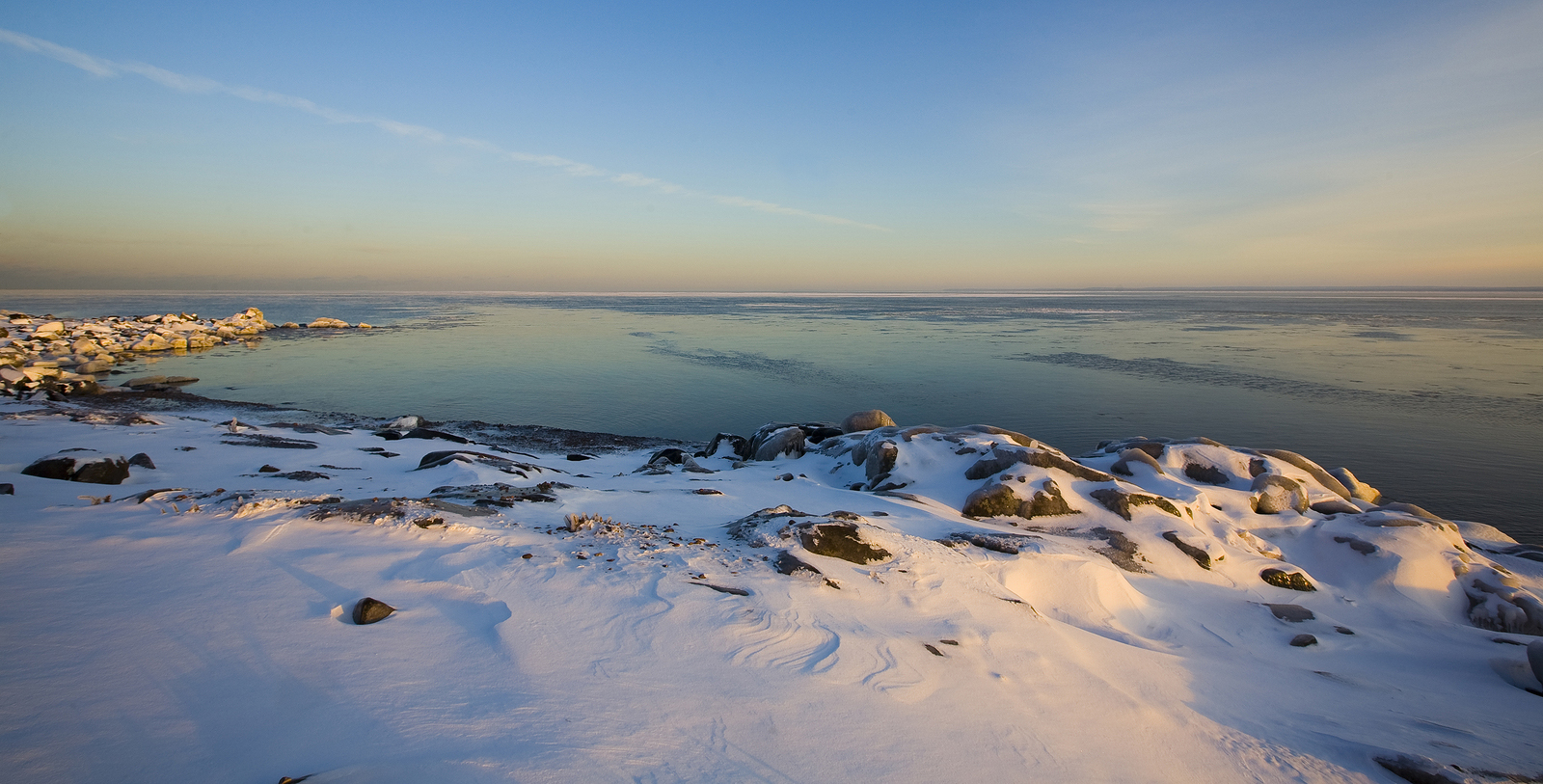
Lake Superior used to freeze shore-to-shore in many winters. In the last 30 years the ice cover has reduced by 50 to 80 percent. (Bigstockphoto.com)
CURWOOD: It's Living on Earth, I'm Steve Curwood.
[INSTRUMENTAL FROM “THE WRECK OF THE EDMUND FITZGERALD”]
CURWOOD: The song "the Wreck of the Edmund Fitzgerald" tells the tale of a cargo ship that met bad weather on the biggest of the Great Lakes - Lake Superior. The boat capsized and killed all 29 of the crew on board.
[LYRICS: The legend lives on from the Chippewa on down
Of the big lake they call Gitche Gumee
The lake, it is said, never gives up her dead
When the skies of November turn gloomy...]
CURWOOD: “Gitche Gumee” is the Ojibwe tribal name for what we call Lake Superior. It means "big water" - a perfect name for what is, by surface area, the largest fresh water lake in the world. It’s also the deepest and coldest of the Great Lakes, but James Kitchell, an emeritus professor at the University of Wisconsin in Madison, says that’s changing.
KITCHELL: Lake Superior is warming faster than any of the other Great Lakes. In fact, it’s warming faster than any lake on the planet. The lake itself, in the past three decades, has warmed three degrees centigrade, which in round numbers would mean six degrees Fahrenheit. And it’s warming at a rate that actually exceeds the melting rate of the ice caps in the Antarctic and the Arctic oceans.
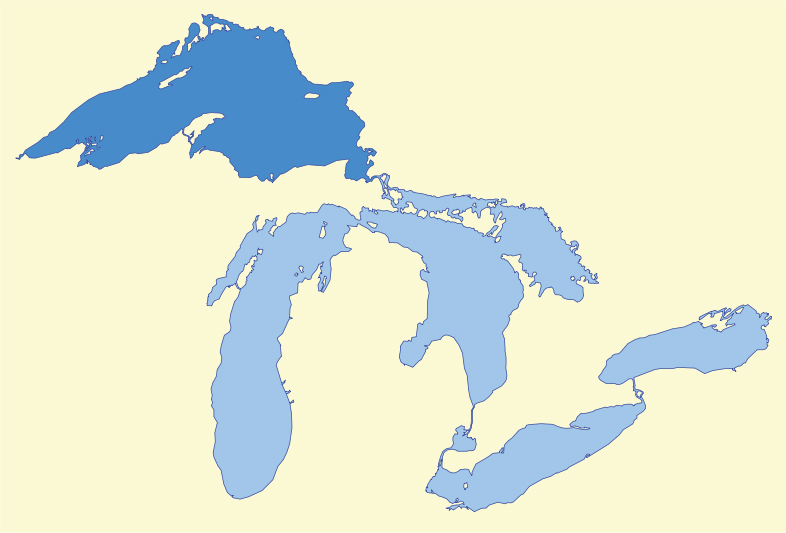
Lake Superior (dark blue) holds more water than all of the other Great Lakes combined. (Wikipedia Creative Commons)
CURWOOD: So wait a second. It’s counterintuitive if the largest of the Great Lakes, Lake Superior, and the coldest, is actually warming more quickly than the smaller lakes in the region. Why is that?
KITCHELL: It’s because of the substantial surface area of Lake Superior which absorbs solar radiation, and yes, it is counterintuitive to say, “my goodness, what has been known as very cold lake is actually getting warmer.” So it is due primarily to this reduction in ice cover, and what’s called an ice albedo effect. Now when there’s ice on the lakes, a lot of that solar energy is reflected back into the atmosphere, but in the most recent three decades, the duration of ice on the lake has reduced by as much as 50 percent or more, and the result is that more solar radiation enters and stays in the water column, and the lake warms more quickly.
KITCHELL: So how has this increase in temperature, some three degrees centigrade, almost six degrees Fahrenheit, how has that affected Lake Superior as habitat for fish?
KITCHELL: Well, because it has been a cold lake, it’s largely been dominated by cold water fishes, but we’re now shifting toward one that would be allowing a greater abundance of cool water fishes, things that do live best at warmer temperatures. The habitat for things like lake trout, which is a native fish and had been the dominant fish as an apex predator in that system, that habitat has been increasing in its extent and duration. In fact, at this point in history, the lake trout in Lake Superior are probably as abundant as they have ever been - and by that I mean ever. When Hiawatha looked out upon Gitche Gumee, there was no commercial fishery, there were no sea lamprey to kill the population of trout, and it now has, because sea lamprey are controlled, the commercial fisheries have been reduced, there are now as many or more trout in Lake Superior than had been the case ever in history.
CURWOOD: How are the local Native American tribes adapting to these changing fish populations?
KITCHELL: They’re participating in the general goal of restoration of the native fish communities in the Great Lakes. Their hatcheries are producing lake trout, they’re producing brook trout, and they’re producing walleye now, which is a relatively new thing for them to do. The walleye is a cool water fish. They had been present in Lake Superior for lots of years, but they’ve been pretty much restricted to the warmer waters near shore and into the shallow bays, but what’s happened as a consequence of this expansion of habitat of the walleye is that their populations have expanded. The walleye in this part of the world, in the Great Lakes region, is held with reverence because they’re so good to eat.
CURWOOD: But I understand that the catch rate for fishermen reflect that change in population dynamics. Can you tell me about that?
KITCHELL: Yes. A decade ago they were catching walleye at about 0.002 fish per day of fishing. They’re now catching 7.2 per day of fishing. That’s a big change, a very big change.
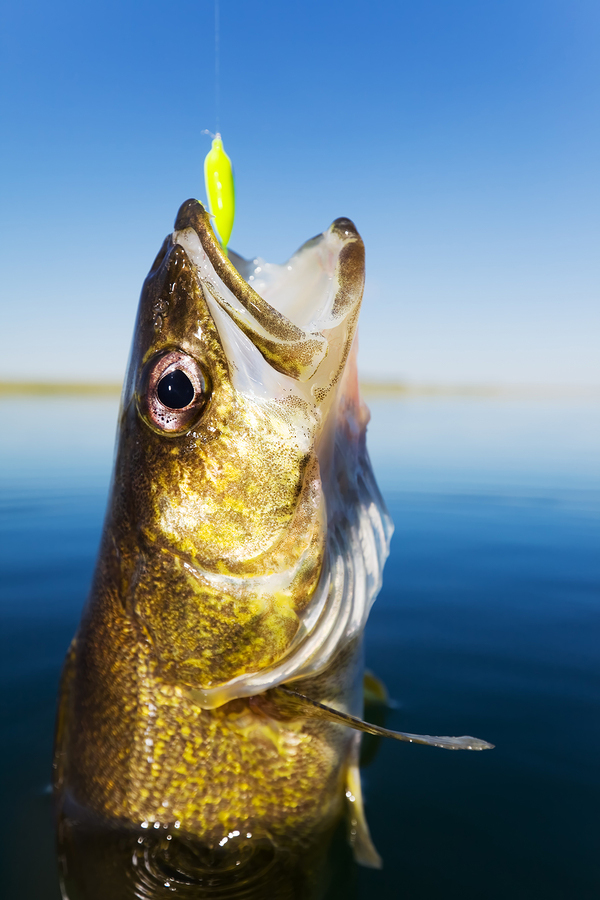
Walleye are a warmer water fish and benefiting from climate change in Lake Superior. (Bigstockphoto.com)
CURWOOD: Professor, how do you think climate change is affecting the local economy when it comes to the fisheries?
KITCHELL: There is substantial possibility that the local economy will increase as a consequence of having walleye. There are going to be more people fishing for walleye that are going to spend money buying bait, buying food, staying in hotels, having a beer with the boys after dinner, those kinds of things. So the economic boost of recreational fishery in the Great Lakes has been phenomenal.
CURWOOD: So we have a situation where over the short term at least there’s a benefit from the warming climate if you’re in the business of fishing for walleye and lake trout.
KITCHELL: Yes, that’s true. There’s a constraint, and the constraint is - there are two constraints - there’s a constraint that more fish means less food per fish, which means growth rates have actually declined some. There are more fish, but they tend to be less than average size. That’s one constraint.
The other constraint is a management challenge. That is sea lamprey, which devastated the lake trout populations in all of the Great Lakes. Temperatures have created more opportunity for sea lamprey and the sea lamprey have an unlimited supply of food. Individual lamprey will kill more fish because they have a longer period of time at preferred temperatures, and that means a greater amount of money must be chartered towards controlling the sea lamprey populations, and that’s a challenge for the Canadian and American governments, and as you may have heard, we don’t have a government right now, and the consequence of that is that we don’t have any money, and it’s unlikely that we’ll have any to respond in ways that actually control the lamprey and that population continues to expand.
CURWOOD: Professor James Kitchell is at the Center for Limnology at the University of Wisconsin in Madison. Thanks so much, Professor.
KITCHELL: Thank you very much for allowing me to tell you some fish stories. I’ve enjoyed that.
Related link:
Center for Limnology
[MUSIC: Robbie Robertson “The Code of Handsome Lake” from Contact From The Underworld Of Redboy (Capitol Records 1998)]
Counting Down the Planet
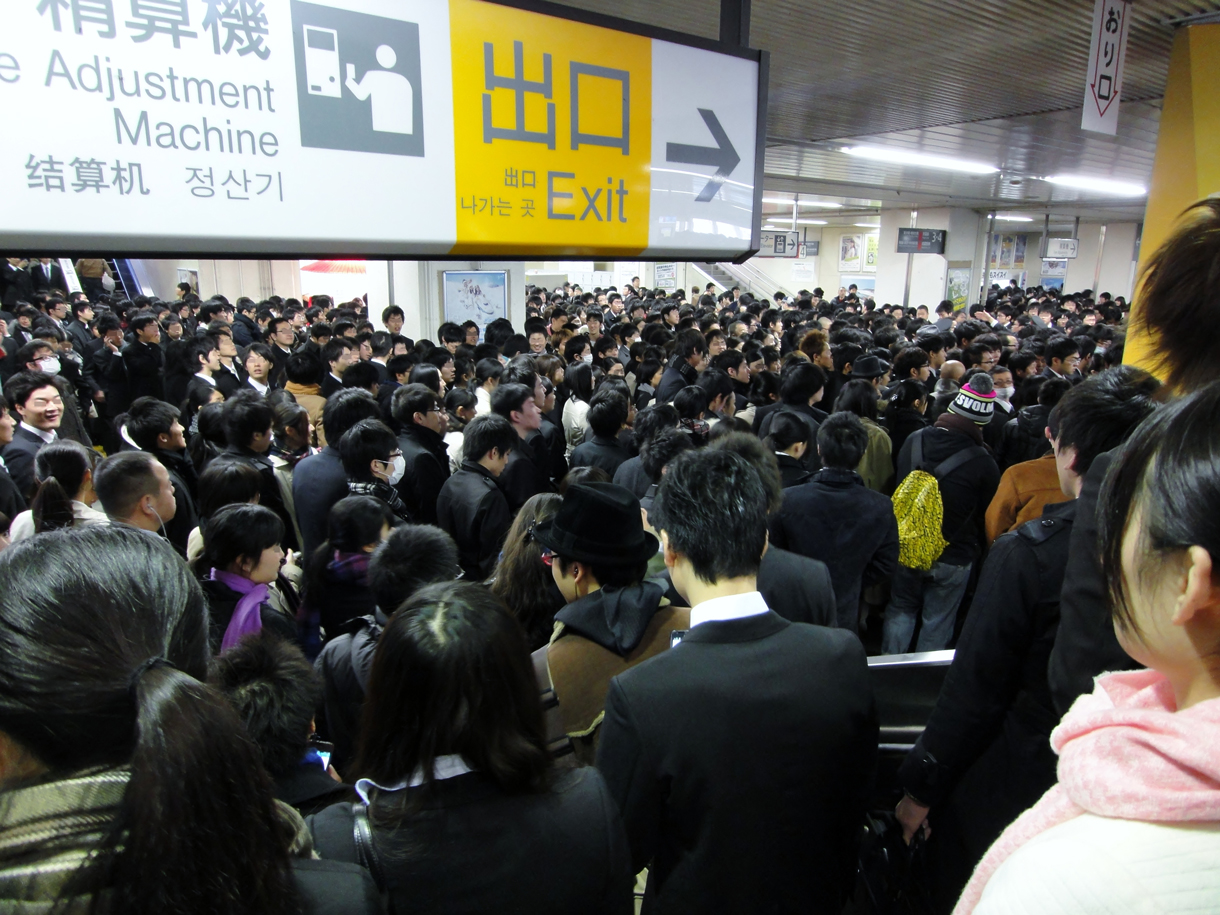
Rush hour in Tokyo. Despite its densely populated cities, Japan’s population is decreasing, forcing it to consider how to design an economy around shrinking, rather than growth. (Photo: Dick Johnson)
CURWOOD: Author Alan Weisman’s last book, the bestseller ‘The World Without Us’, imagines what the world might be like if there were no humans. Well, his new book, ‘Countdown’, examines a vastly different reality - a world with what might be way too many humans. Those seem like two dark futures, so we called him up to ask him about this latest work. Alan, welcome back to Living on Earth.
WEISMAN: Thanks, Steve, it's great to be back.
CURWOOD: Alan, your previous book, ‘The World Without Us’, was, well, let’s face it, very dark. How fair is it to characterize this work as hopeful?
WEISMAN: Well, Steve, I didn’t consider ‘The World Without Us’ as dark. To me, it was very hopeful to realize that nothing that we do to this planet ultimately is going to harm it. In this book, I really show a way, that we can continue to have a world with us, that gradually, not coercively, we can bring our numbers back down to a much more reasonable balance with the rest of nature, we can curb the amount of people who are emitting carbon into the atmosphere.
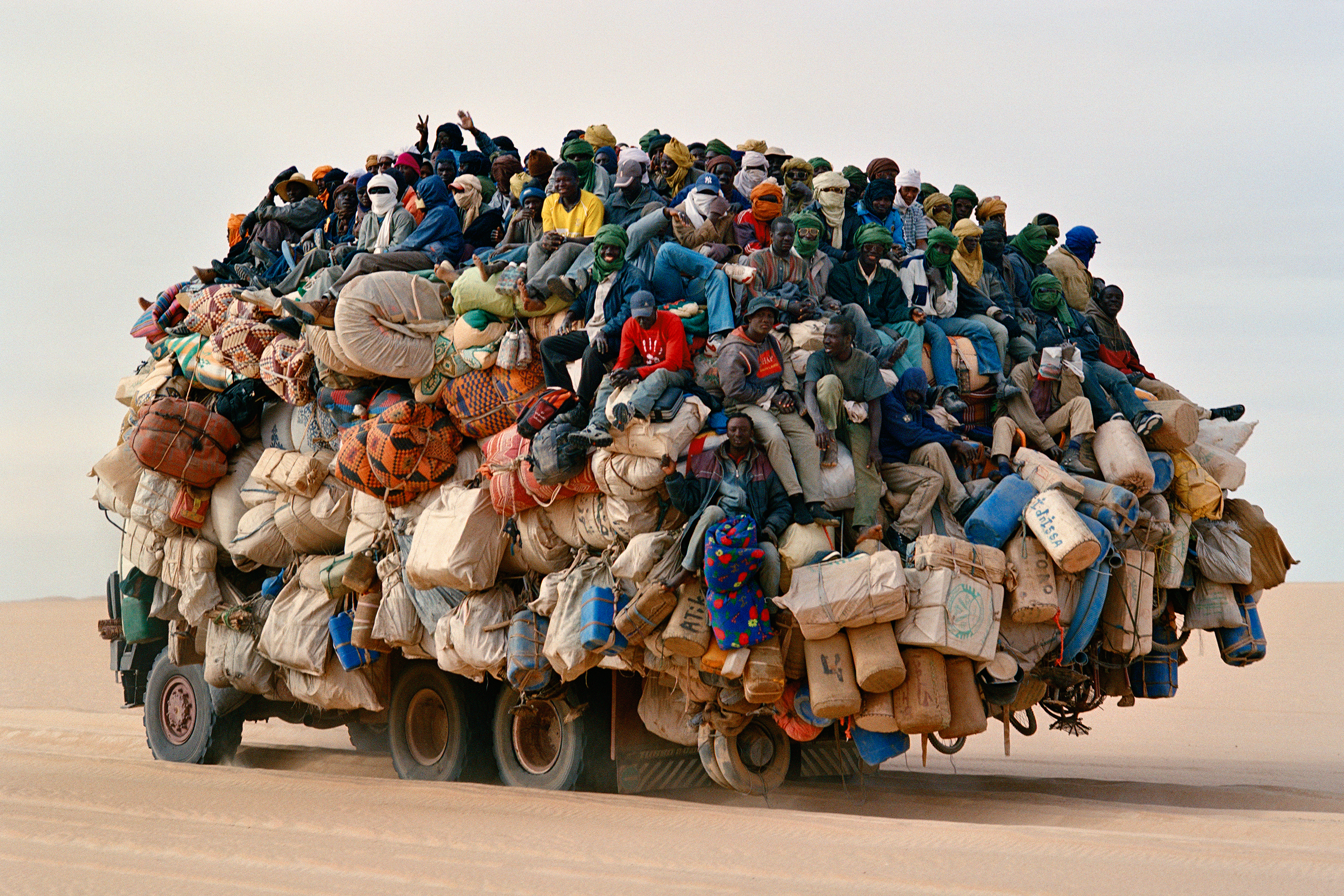
Transport in the Sahel, Africa. Population is growing quickly in this impoverished region of Africa, and rural subsistence farmers are increasingly migrating to cities. (Photo: Roberto Neumiller)
That’s really one of the most hopeful things we can possibly be doing right now. Plus, it doesn’t cost very much. We could provide contraception worldwide for everybody for the same amount every year, about $8.5 billion, that your country and mine was spending in Iraq and Afghanistan every month.
CURWOOD: At one point, you outline four questions in the book as the most important questions on earth. One of the four questions you investigate is what is the planet’s carrying capacity? Can you speak to that for me please?

Alan Weisman, Golestan National Park, Iran. Weisman visited 21 countries, including Iran, in researching Countdown. (Photo: Beckie Kravetz)
WEISMAN: Well, a lot of experts who have kind of made a stab at what might be a reasonable number for us, some of them have looked at energy, trying to figure out how much carbon the atmosphere really can bear. Divide all that stuff up, and you start coming out with numbers in the two to three billion range. It turns out that it’s hard to know exactly what the optimum number is because we’re at the number that we’re at right now.
CURWOOD: Which is about seven billionish or so.
WEISMAN: It’s about 7.2 billion right now, and it’s one of these things that sort of creeps up on us gradually, you know, every few days, there’s a million more, and you don’t really notice until suddenly you turn around, you say, “Oh my God, there’s all this carbon dioxide in the air. Look what it’s starting to do.”
CUTWOOD: The first question’s about the Earth’s carrying capacity. Tell us about the other three and just briefly sum up the answer for each.
WEISMAN: The second one, the converse, is how much nature do we need? Are there any species that are absolutely essential? And the answer to that one turns out to be, we really won’t know until it’s too late if we push something off the planet that, “Ooops. We probably should have saved that.” You don’t notice that one species is gone. You don’t notice that a second species is gone. Suddenly, when there are a thousand species gone then we start to have a real problem.
CURWOOD: So that’s the second question - what’s the third question?

Crowds of demonstrators protest housing shortage in Tel Aviv in August 2011. Parts of Israel are some of the most densely populated regions on Earth, and growing. (Photo: Avivi Aharon)
WEISMAN: The third question was, OK suppose we could determine what would be an optimum population, or we decided at least the 7.2 billion that we have right now is just way too many because we’re really bursting at the seams. Would the great range of the world’s cultures and religions and nationalities embrace the idea that this would be in their self interests? And if the Chinese draconian policy is not going to fly almost anywhere else.
So I ended up going to 21 countries for this book to sort of take the pulse of the world’s cultures, and to see if there is something in their histories, and it turns out I found something everywhere. I was in lots of Muslim countries, I was in the Vatican, I was in Israel, and here’s one example.
Let’s go back to Genesis, there is a charge to be fruitful and multiply and fill the Earth. But then you get to Joseph who was one of 13 children - you know the son of Jacob. He was very observant, and he realized that the world was moving into a cycle of scarcity. He had only one wife, he held himself to only two children, and he convinced the pharaoh of Egypt in that order to save his country that they literally had to refrain from embracing for a while to conserve. As a result, Egypt got through the famine.
CURWOOD: And the fourth question?
WEISMAN: The fourth question is how do we design an economy that would allow us to prosper without constant growth? Constant growth is usually the measure by which we determine an economy is healthy or not. Constant economic growth depends on population growth. You have to have more consumers, and you have to have more laborers.
CURWOOD: Why is population control still such a reviled notion? Even with so many red flags that however you do the math the human population is outweighing the planet’s carrying capacity for humans?
WEISMAN: Well, making copies of ourselves is something that every organism on the planet does, it’s doing what comes naturally, and the idea of having to limit it is sort of an unnatural act. There is something instinctively reflexive that finds the idea of having to control that, or worse, being told what you have to control it utterly repellant. No species is created with an idea of limitations. You make not just copies of yourself, but you make extra copies of yourself and hope that some of them will survive.
The human race, like every other species, used to lose an awful lot of those extra copies. In the 19th century, we suddenly changed the game. We invented all kinds of medical advances, from vaccinations to eradication of pests, to pasteurization of milk, and then we came up with food technology that greatly increased the amount of plant life that the Earth could produce by itself. The fact is, we have really manipulated nature when it comes to human survival.
CURWOOD: Now why do you think it’s going to be easier to get a balance here by curbing births rather than using technology - cleaner energy or food, that sort of thing?
WEISMAN: The fact is, we’re not developing solar, wind and other kinds of clean technologies to the point where they can usurp the more conventional ways of producing energy.
CURWOOD: What about the prospect of consuming less?
WEISMAN: There’s also the question of consumption. Everybody says, “Well, if only we consumed less, then the world would be much better and cleaner and much more sustainable.” I think it was Paul Eherlich who said to me, “It’s a great idea, but I’ve never found a condom for consumption.” The quickest way we can deal with environmental issues right now is simply to curb the number of consumers who are pumping out all that carbon.
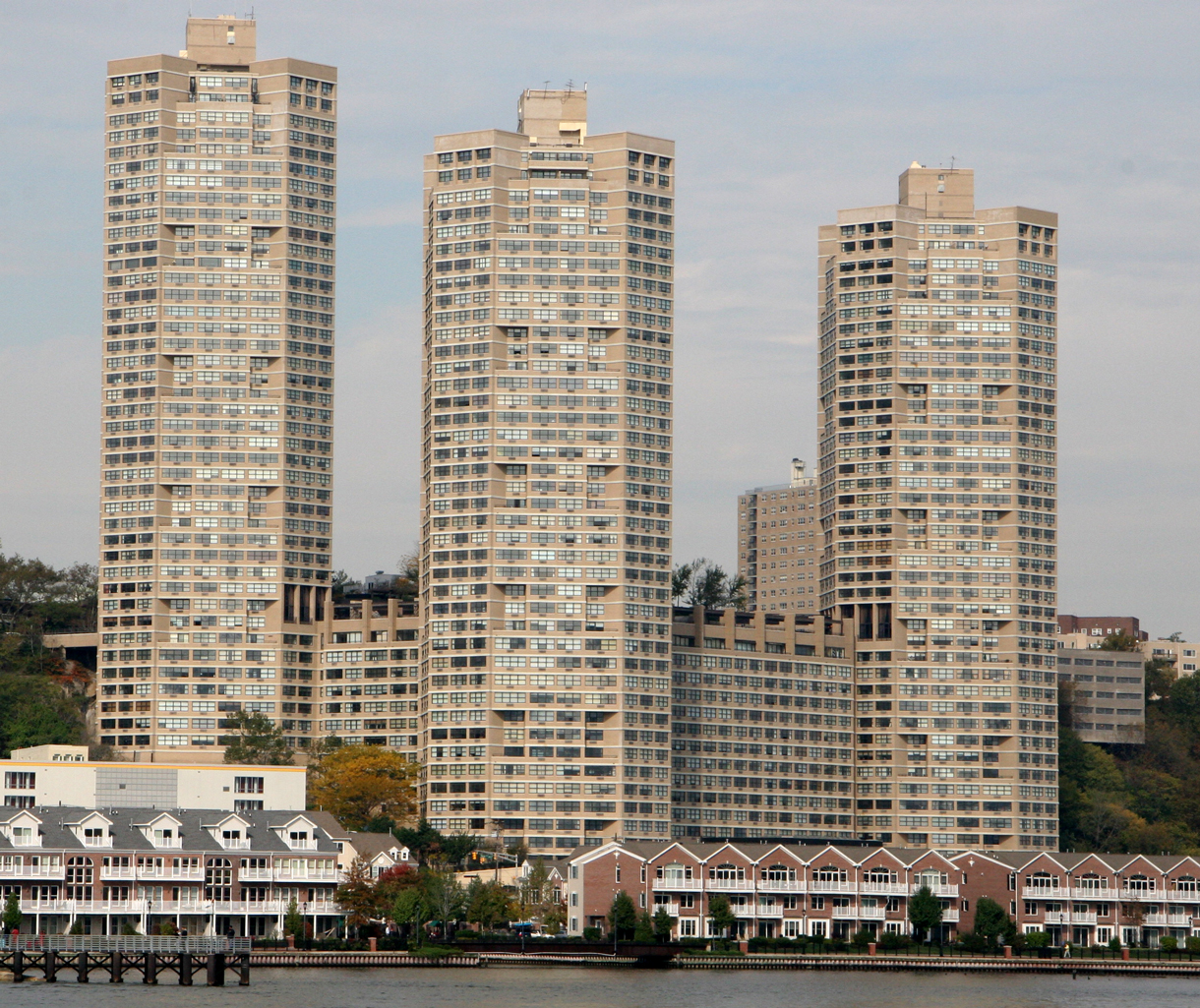
Apartment blocks in Guttenberg, N.J., the most densely populated incorporated place in the U.S. (Photo: Alexander Krivenyshev)
CURWOOD: If the Earth can’t hold the 10 billion we’re on track for, or for that matter, the seven billion we have now, how do you build an economy around a shrinking population?
WEISMAN: Well, one of the places I went to in this book is Japan which is the first country on Earth really that is facing the fact that its population is shrinking. At the end of World War II, they had to cut off their baby boom because people were starving. So they legalized abortion. This was before modern contraception, and that was the fastest way to do it, and as a result, they’re going to be back to their post World War II population by around the middle of this century, a little bit after.
I found a Japanese economist who’s been thinking about this a lot. His name is Akihito Matsutani. He says it’s really an opportunity for Japan to reorient itself. Instead of depending on heavy export industries that load people into these port cities, it’s going to be a time of lighter consumer industries - a cheaper place to live, labor will actually become very valuable.
CURWOOD: But Japan right now is in an economic funk! It had this great expansion in the 80s, but then it’s been in stagnation for almost two decades now.
WEISMAN: Well, Japan is kind of in denial over what it’s facing. But frankly, economic stagnation in Japan would look really good to most of the people on Earth. You still go to Japan and people are prosperous, people are living well.
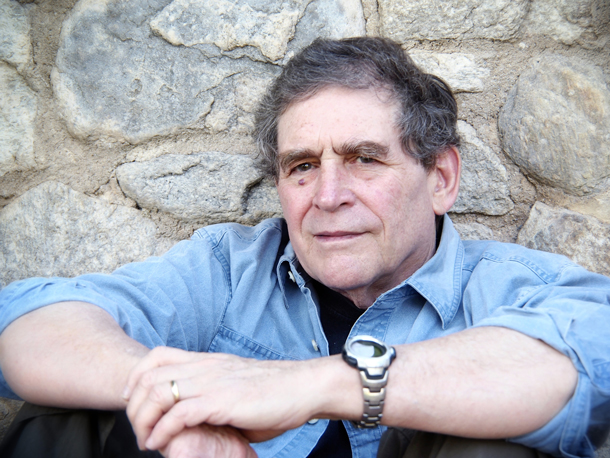
Alan Weisman (Photo: Bill Steen)
CURWOOD: Alan, this is a very thoughtful and almost exhaustive study of these questions. What do you hope comes out of your book?
WEISMAN: Well, there’s something inexpensive that is a win-win, or a triple or quadruple win situation for everybody that can help turn around population growth significantly in this century - encourage women to get educated. Turns out, education is the best contraceptive of all. A girl who gets into high school worldwide on the average is going to have two children. If she gets a degree, she’s going to delay her childbearing until her college is over. She’s going to have something very useful to both her family and her society. The idea that educating women can help solve this environmental problem, and at the same time bring equality. You know, population, as one of my sources explained to me, is where social science and natural science come together. Right now, they’re colliding. We can really make them mesh the way that everything in an ecosystem ought to do.
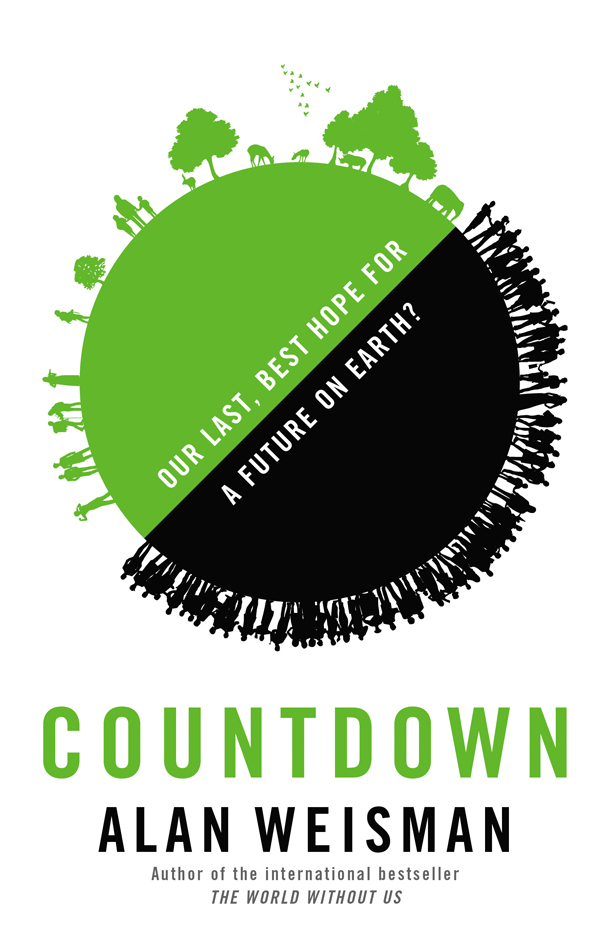
Countdown cover
CURWOOD: Alan Weisman’s book ‘Countdown’ is out now from Little Brown. Alan, thanks so much for taking the time to talk with me today.
WEISMAN: You're welcome, Steve, it's been a pleasure.
Related links:
- Countdown site
- Countdown book trailer (YouTube)
- Paul Ehrlich (Stanford)
[MUSIC: Snarky Puppy “Minjor” from goundUP (Ropeadope Records 2012)]
CURWOOD: Living on Earth is produced by the World Media Foundation. Naomi Arenberg, Bobby Bascomb, Emmett Fitzgerald, Andrew Keys, Helen Palmer, Kathryn Rodway, Adelaide Chen, James Curwood, Jennifer Marquis and Gabriela Romanow all help to make our show. Jeff Turton is our technical director. Alison Lirish Dean composed our themes. You can find us anytime at LOE.org, and like us on our Facebook page - it’s PRI’s Living on Earth. And we tweet from @LivingOnEarth. I'm Steve Curwood. Thanks for listening.
ANNOUNCER 1: Funding for Living on Earth comes from the Grantham Foundation for the protection of the environment. Supporting strategic communications and collaboration in solving the world’s most pressing environmental problems. The Kendeda Fund, furthering the values that contribute to a healthy planet, and Gilman Ordway for coverage of conservation and environmental change. Living on Earth is also supported by a friend of Red Tomato, supplier of righteous fruits and vegetables from northeast family farms. www.redtomato.org. This is PRI, Public Radio International.
ANNOUNCER 2: PRI, Public Radio International.
Living on Earth wants to hear from you!
Living on Earth
62 Calef Highway, Suite 212
Lee, NH 03861
Telephone: 617-287-4121
E-mail: comments@loe.org
Newsletter [Click here]
Donate to Living on Earth!
Living on Earth is an independent media program and relies entirely on contributions from listeners and institutions supporting public service. Please donate now to preserve an independent environmental voice.
NewsletterLiving on Earth offers a weekly delivery of the show's rundown to your mailbox. Sign up for our newsletter today!
 Sailors For The Sea: Be the change you want to sea.
Sailors For The Sea: Be the change you want to sea.
 The Grantham Foundation for the Protection of the Environment: Committed to protecting and improving the health of the global environment.
The Grantham Foundation for the Protection of the Environment: Committed to protecting and improving the health of the global environment.
 Contribute to Living on Earth and receive, as our gift to you, an archival print of one of Mark Seth Lender's extraordinary wildlife photographs. Follow the link to see Mark's current collection of photographs.
Contribute to Living on Earth and receive, as our gift to you, an archival print of one of Mark Seth Lender's extraordinary wildlife photographs. Follow the link to see Mark's current collection of photographs.
 Buy a signed copy of Mark Seth Lender's book Smeagull the Seagull & support Living on Earth
Buy a signed copy of Mark Seth Lender's book Smeagull the Seagull & support Living on Earth

